AzureWave Technologies NH931 IEEE 802.11b/g/n Wireless LAN, Bluetooth and FM Rx Combo Half Mini Card User Manual
AzureWave Technologies, Inc. IEEE 802.11b/g/n Wireless LAN, Bluetooth and FM Rx Combo Half Mini Card
Contents
- 1. User Manual
- 2. Manual
User Manual
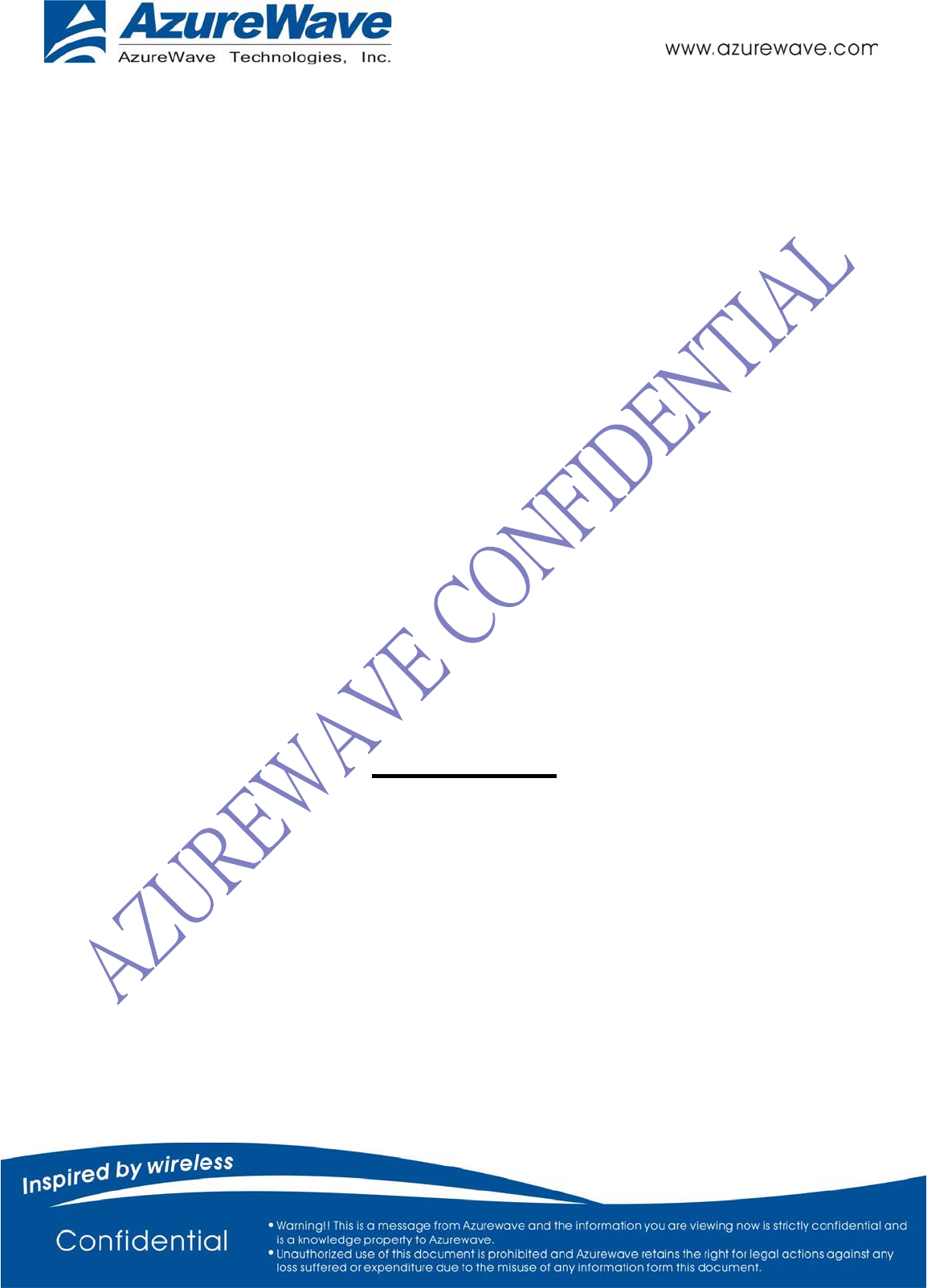
AW-NH931
IEEE 802.11 b/g/n Wireless LAN, Bluetooth
and FM Rx Combo Half Mini Card
Datasheet
Version 0.6
-1-
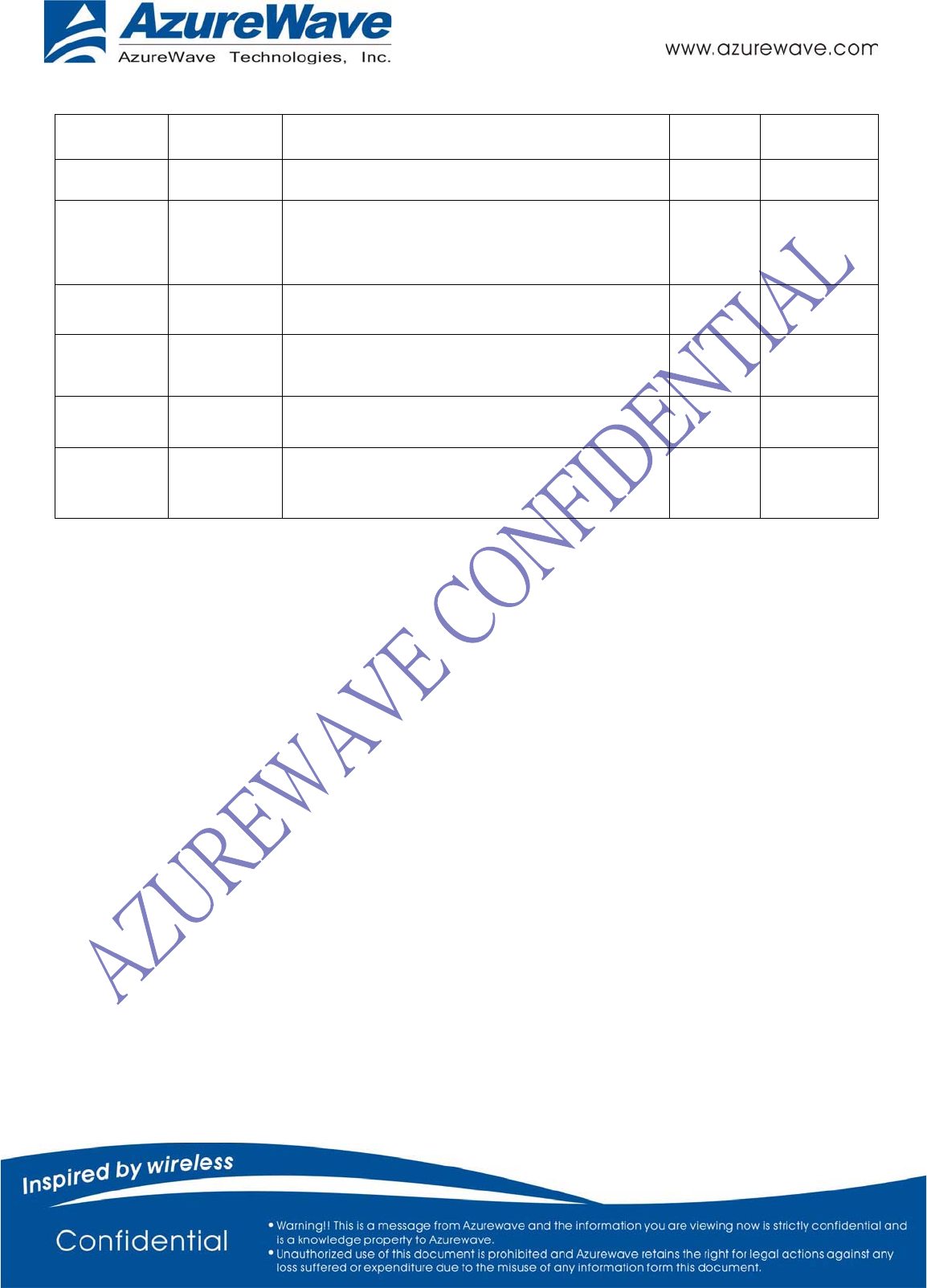
Document
release Date Modification Initials Approved
Version 0.1 2010/10/11 Initial Version N.C.
Chen CE Huang
Version 0.2 2010/12/3
Update Bluetooth output power spec.
output power item on page 8
6.5dBm(Typ.)
Æ
Class 1.5 @ 7 dBm (±2 dBm)
Class 2 @ 2 dBm (
̈́
2dBm)
N.C.
Chen CE Huang
Version 0.3 2010/12/14 Update “Operating Temperature” on page 7
Add 2-7. “Power-on sequence” on page 19
N.C.
Chen CE Huang
Version 0.4 2010/12/24
Update
Section 5. “Antenna port information” on
page 27
N.C.
Chen CE Huang
Version 0.5 2011/1/5 Update page 7 Electrical Specifications
Number of Channels item on page 7
N.C.
Chen CE Huang
Version 0.6 2011/1/12
Update page7 Electrical Specifications
Frequency Range description on page 7
2.4G/5GHz
Æ
2.4GHz band
N.C.
Chen CE Huang
-2-
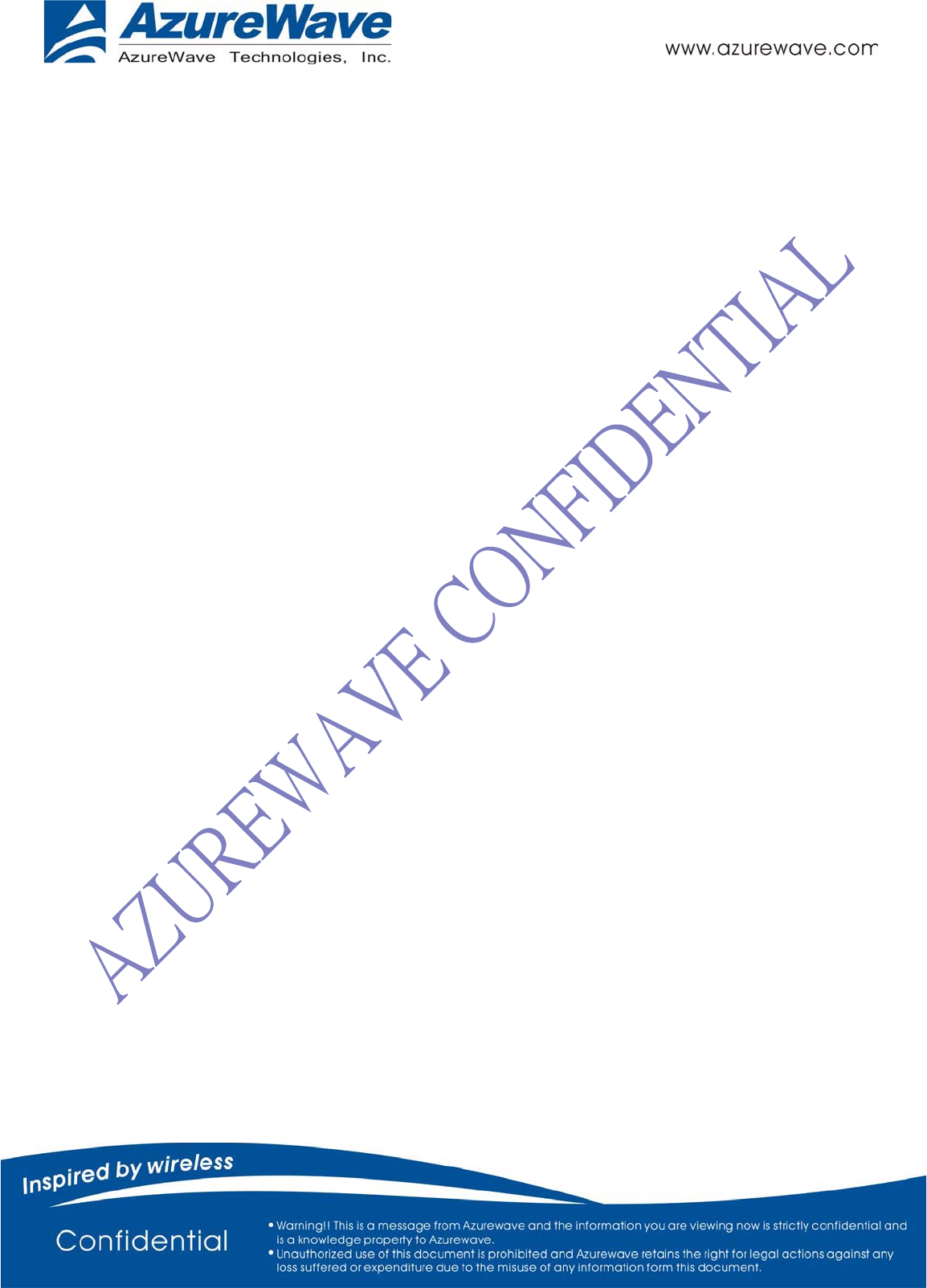
Table of Contents
1. General Description
1-1.Product Overview and Functional Description
1-2. Key Features
1-3. Specifications Table
2. Electrical Characteristic
2-1. Absolute Maximum Ratings
2-2. Recommended Operating Conditions
2-3. DC Characteristics for Host I/O
2-4. BT/FM Host Interface
2-5. SDIO Timing
2-6. LPO Clock (RTC_CLK)
2-7. Power-On sequence
3. Pin Definition
3-1. Pin Description
3-2. Pin Description comparison with PCI-Express specification
4. Mechanical Information
5. Antenna port Information
-3-
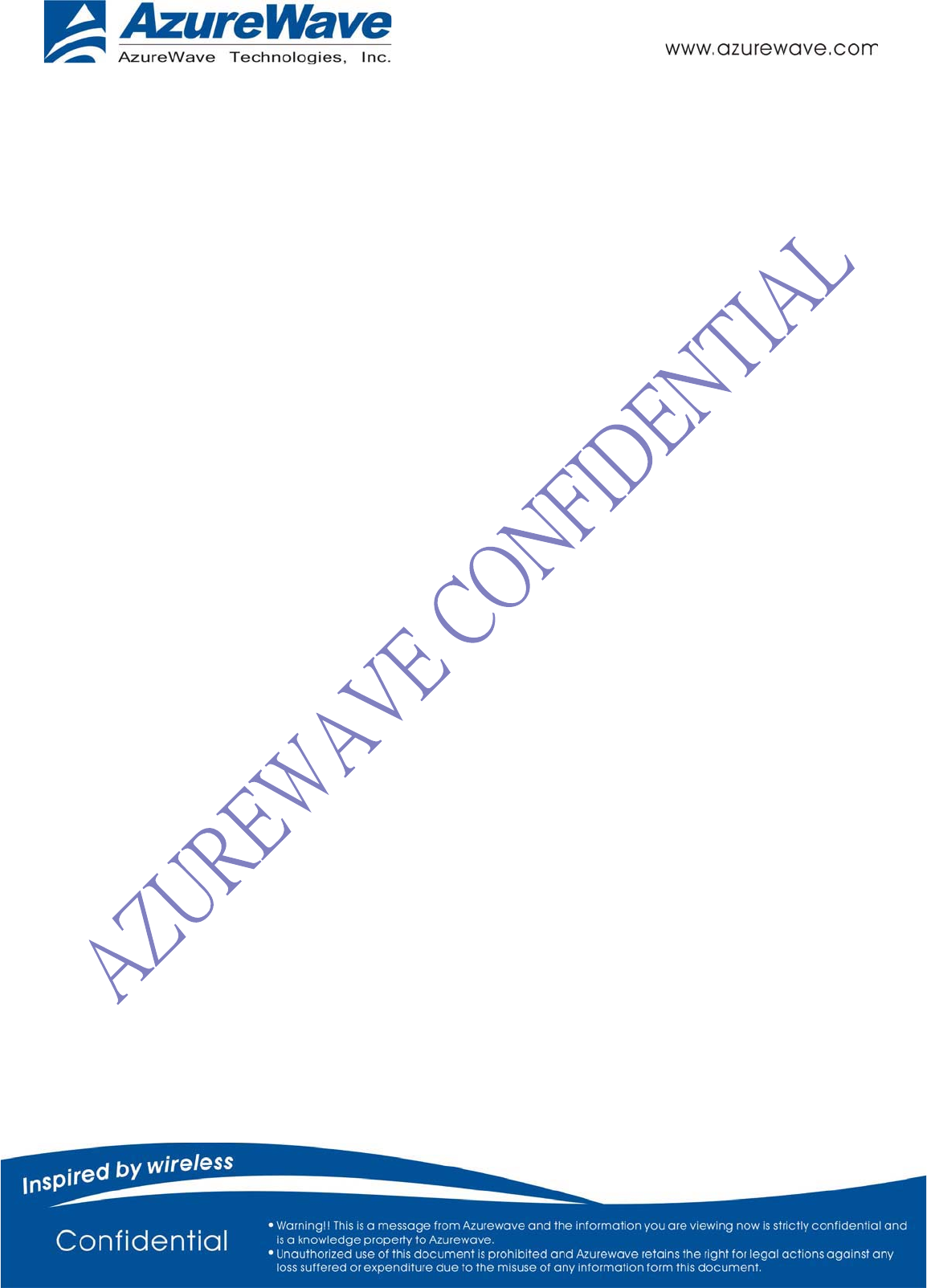
1. General Description
1-1. Product Overview and Functional Description
AzureWave Technologies, Inc. introduces the first IEEE 802.11b/g/n WLAN, Bluetooth and FM combo
module - AW-NH931. The module is targeted to mobile devices including, Digital Still Cameras (DSCs),
Portable Media Players (PMPs), and Gaming Devices, mobile phones which need small footprint
package, low power consumption, multiple OS support. By using AW-NH931, the customers can easily
enable the Wi-Fi, BT and FM embedded applications with the benefits of high design flexibility, short
development cycle, and quick time-to-market.
Compliance with the IEEE 802.11b/g/n standard, the AW-NH931 uses DSSS,OFDM,DBPSK,DQPSK,
CCK and QAM baseband modulation technologies. A high level of integration and full implementation of
the power management functions specified in the IEEE 802.11 standard minimize the system power
requirements by using AW-NH931. In addition to the support of WPA/WPA2 (personal) and WEP
encryption, the AW-NH931 also supports the IEEE 802.11i security standard through AES and TKIP
acceleration hardware for faster data encryption. The AW-NH931 is also Cisco Compatible Extension
(CCX) certified. For the video, voice and multimedia applications the AW-NH931 support 802.11e
Quality of Service (QoS).
For Bluetooth operation, the AW-NH931 is Bluetooth 2.1+Enhanced Data Rate (EDR) compliant. The
AW-NH931 supports extended Synchronous Connections (eSCO), for enhanced voice quality by
allowing for retransmission of dropped packets, and Adaptive Frequency Hopping (AFH) for reducing
radio frequency interference. It provides easier to connect devices, lower power consumption and
improved security.
For FM receiver/transmitter, the AW-NH931 is 76-MHz to 108-MHz FM bands supported and supports
the European Radio Data Systems (RDS) and the North American Radio Broadcast Data System
(RBDS) modulations.
The AW-NH931 supports standard interface SDIO v1.2 (4-bit and 1-bit) for WLAN, High-speed UART
interface for BT/FM host controller interface, and PCM for BT audio data. The demodulated FM audio
signal is available as line-level analog stereo output. AW-NH931 is suitable for multiple mobile
processors for different applications. With the combo functions and the good performance, the AW-
NH931 is the best solution for the consumer electronics and the laptops.
-4-
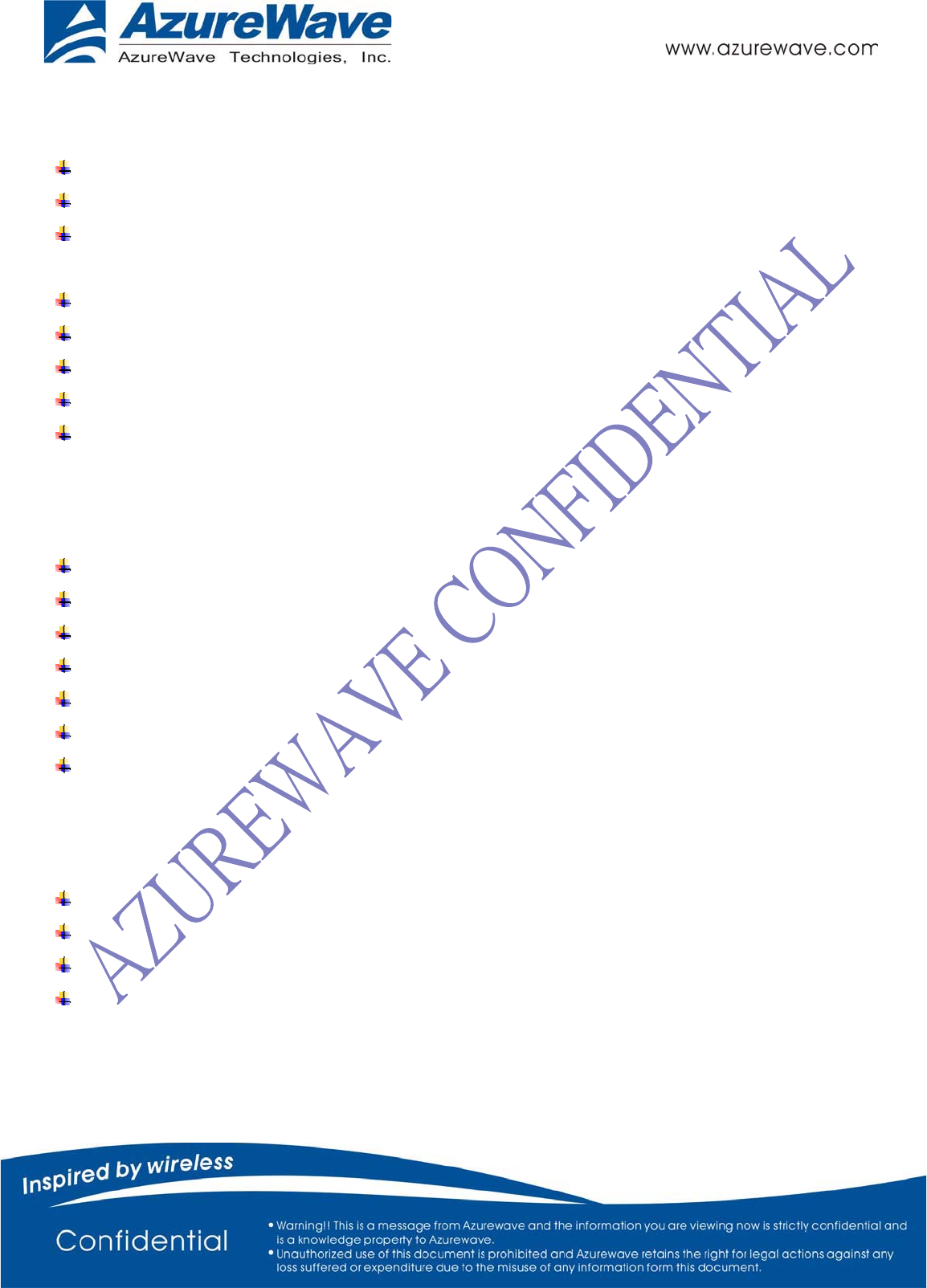
1-2. Key Features
General
Integrates Broadcom solutions of BCM4329 WiFi/BT/FM SoC
SDIO interfaces support for WLAN
ECI—enhanced coexistence support, ability to coordinate BT SCO transmissions
around WLAN receives
High speed UART and PCM for Bluetooth
FM subsystem control through Bluetooth HCI interface
Flexible Power Supply(2.3V~5.5V)
Multiple power saving modes for low power consumption
Lead-free /Halogen Free Design
WLAN
Single - band 2.4 GHz 802.11 b/g/n
Supports antenna diversity
Supports IEEE 802.11d, e, h,i, j,r,k,w
Security–WEP, WPA/WPA2 (personal), AES (HW), TKIP (HW), CKIP (SW).
WMM/WMM-PS/WMM-SA
Proprietary protocol –CCXv2/CCXv3/CCXv4/CCXv5, WFAEC
Integrated CPU with on-chip memory for a complete WLAN subsystem minimizing
the need to wake up the applications processor
Bluetooth
Fully supports Bluetooth Core Specification version 2.1 + EDR features
Support BT3.0
Maximum UART baud rates up to 4 Mbps
Multipoint operation with up to seven active slaves
-5-
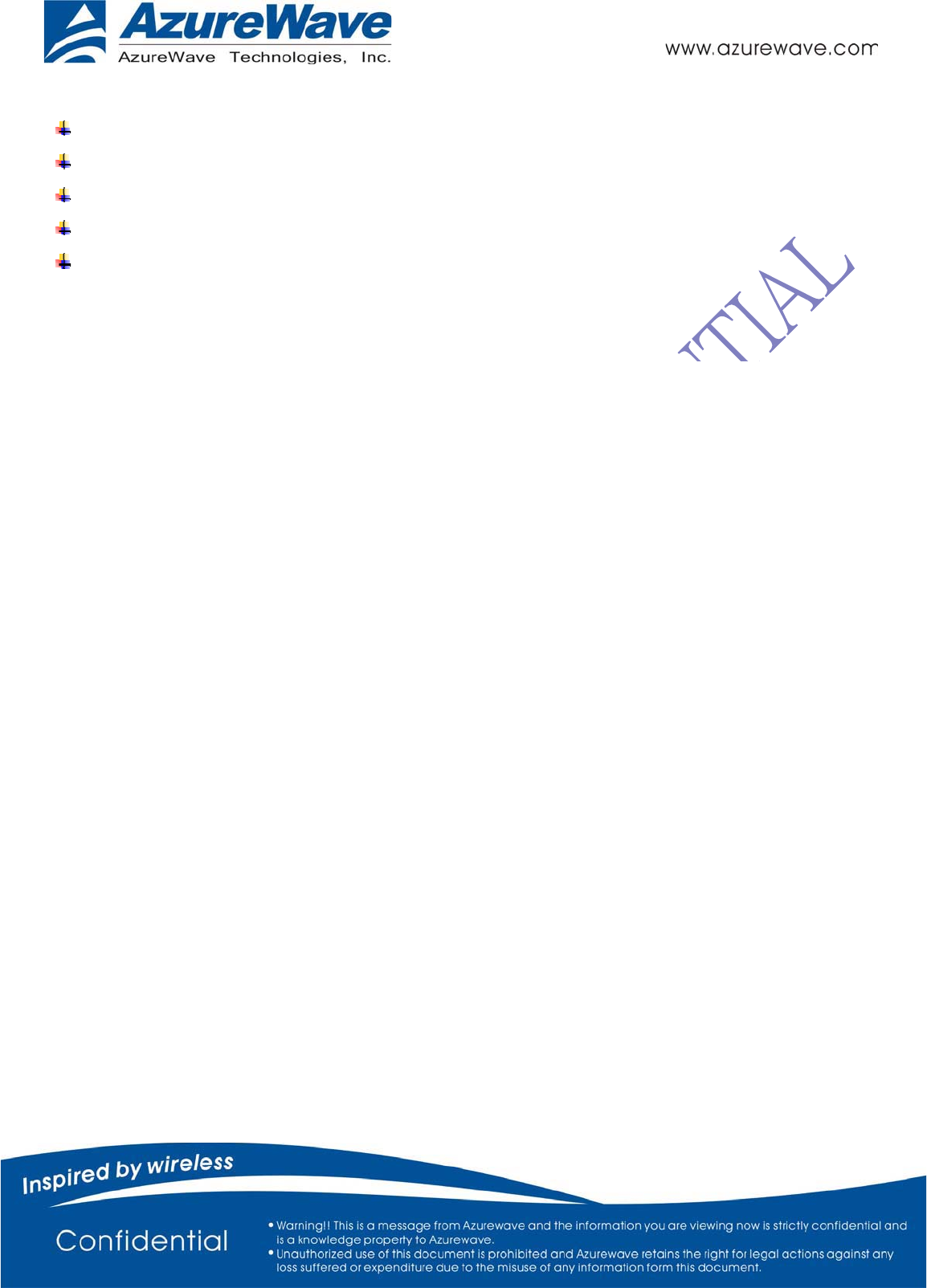
FM
76-MHz to 108-MHz FM bands supported (US, Europe, and Japan)
RDS and RBDS demodulator and decoder with filter and buffering functions
Auto search and tuning modes
FM line-level analog stereo output available
By customer request
Block Diagram
A simplified block diagram of the AW-NH931 module is depicted in the figure below.
VBAT 2.3~5.5V for
internal PMU
A
NT 1
BCM4329
SP3T BPF
2.4 GHz WLAN Rx/BT Rx
2.4 GHz BT Tx
XTAL
FM Rx
Antenna
FM Rx
RTC
_
Clk
32.768KHz
2.4 GHz WLAN Tx
UART for BT/FM
SDIO for WLAN
PCM for BT
Analog Line-out/in for FM
SW
A
NT 2
-6-
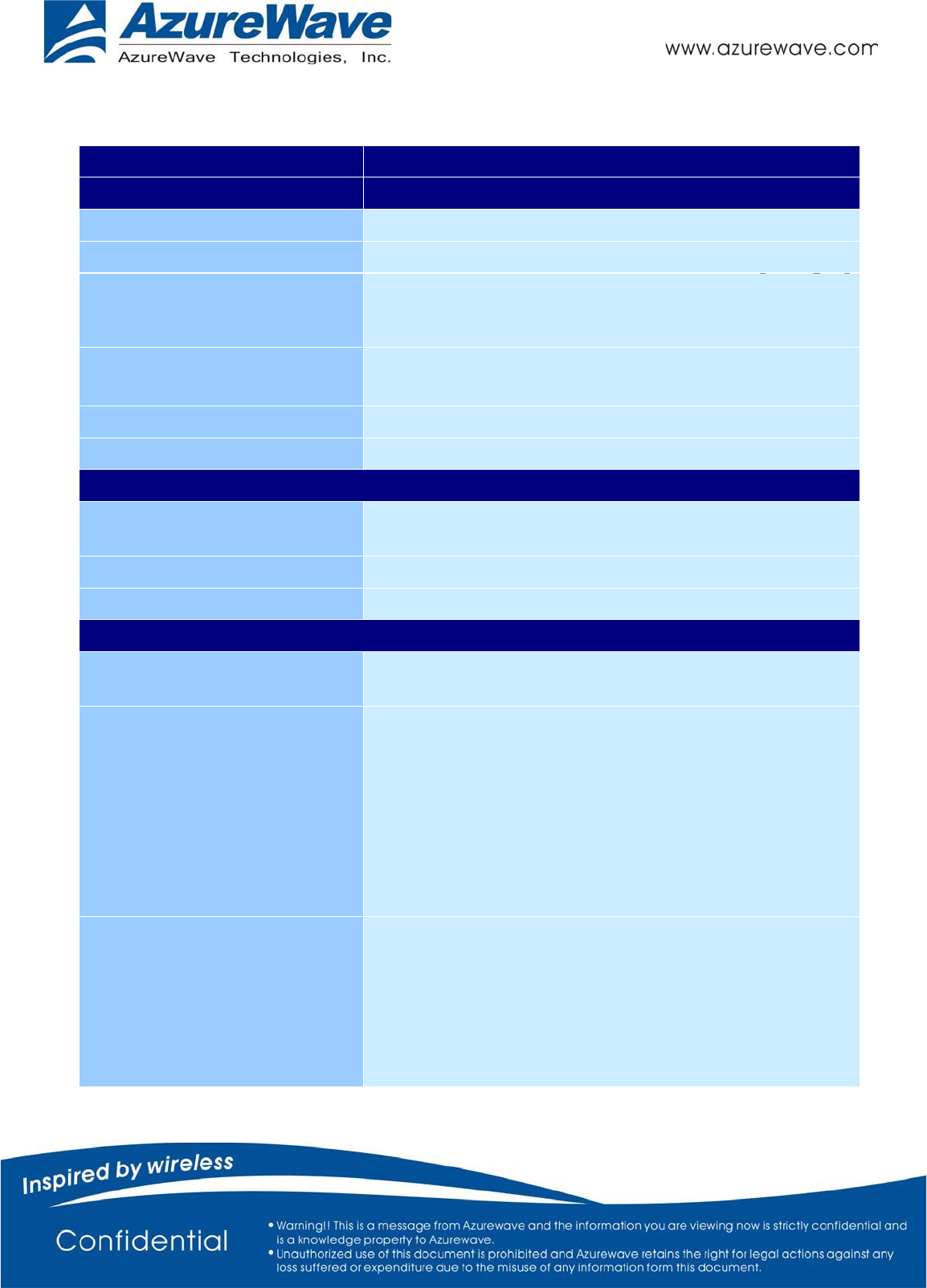
1-3. Specifications Table
*Specifications are subject to change without notice
Model Name AW-NH931
Product Description Wireless LAN &Bluetooth & FM
WLAN Standard IEEE 802.11b/g/n, Wi-Fi compliant
Bluetooth Standard Bluetooth 2.1+Enhanced Data Rate (EDR) / BT3.0
Host Interface SDIO for WLAN
UART for Bluetooth and FM
Audio Interface Digital PCM for Bluetooth.
Analog line level i/o for FM.
Dimension 26.6 mm X 29.8 mm x 3.2 mm
Package Half mini card package
Operating Conditions
Voltage Input supply for internal PMU: 2.3 ~ 5.5V
Input supply for host I/O : 1.8 to 3.3V
Temperature Operating: 0 ~ 70oC ; Storage: -40 ~ 85oC
Relative Humidity < 60 % ( storage) <85% (operation)
Electrical Specifications
Frequency Range 2.4 GHz Band
76 MHz to 108 MHz FM bands
Number of Channels
802.11b: USA, Canada and Taiwan – 11
Most European Countries – 13
Japan – 14
802.11g: USA and Canada – 11
Most European Countries – 13
802.11n: North America – 11
Most European Countries – 13
Modulation
*DSSS, OFDM, DBPSK, DQPSK, CCK, 16-QAM, 64-QAM for WLAN
*GFSK (1Mbps), Ȇ/4 DQPSK (2Mbps) and 8DPSK (3Mbps) for
Bluetooth
-7-
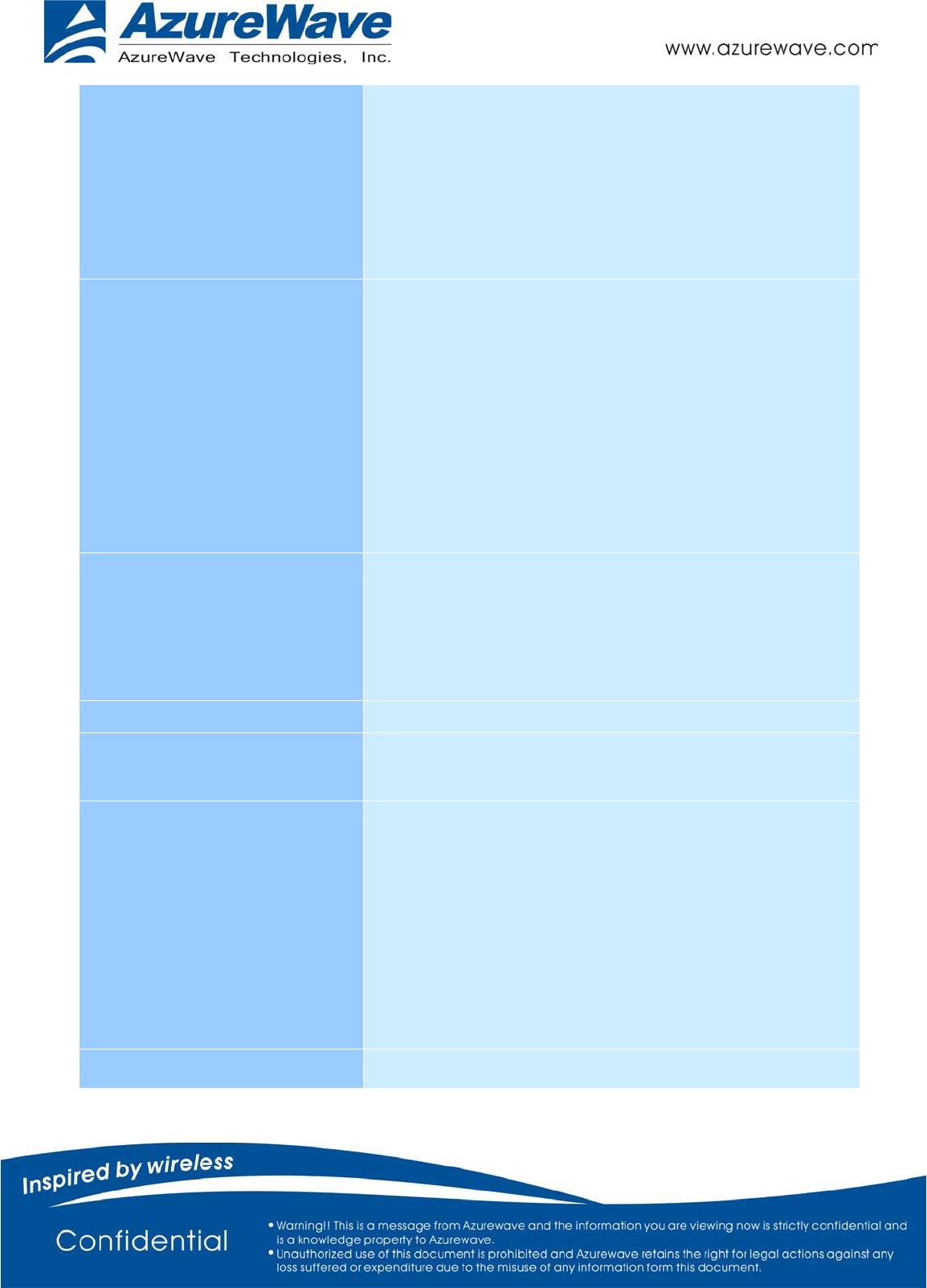
Output Power
WLAN:
11b: 16 dBm (
̈́
2dBm)
11g: 15 dBm (
̈́
2dBm)
11n: 13 dBm (
̈́
2dBm)
Bluetooth:
Class 1.5 @ 7 dBm (
̈́
2dBm)
Class 2 @ 2 dBm (
̈́
2dBm)
Receive Sensitivity
WLAN:
11b (11Mbps): -84 dBm
11g (54Mbps): -70 dBm
11n (HT20 MCS7): -66 dBm
Bluetooth:
GFSK: -83 dBm
ʌ/4-DQPSK: -86 dBm
8-DPSK: -81 dBm
FM:
0 dBuV (Audio)
Data Rates
WLAN
802.11b: 1, 2, 5.5, 11Mbps
802.11g: 6, 9, 12, 18, 24, 36, 48, 54Mbps
802.11n:MCS 0~7 HT20
Bluetooth
Bluetooth 2.1+EDR data rates of 1,2, and 3Mbps
Power Consumption Not specified.
Operating Range
Open Space: ~300m ; Indoor: ~100m for WLAN
Minimum 10 m indoor for Bluetooth
(The transmission speed may vary according to the environment)
Security
WPA™- and WPA2™- (Personal) support for powerful
encryption and authentication
AES and TKIP acceleration hardware for faster data encryption
and 802.11i compatibility
Cisco® Compatible Extension- (CCX, CCX 2.0, CCX 3.0, CCX
4.0,CCX5.0) certified
SecureEasySetup™ for simple Wi-Fi® setup and WPA2/WPA
security configuration
Wi-Fi Protected Setup (WPS)
WEP
CKIP(Software)
Operating System Compatibility TBD
-8-
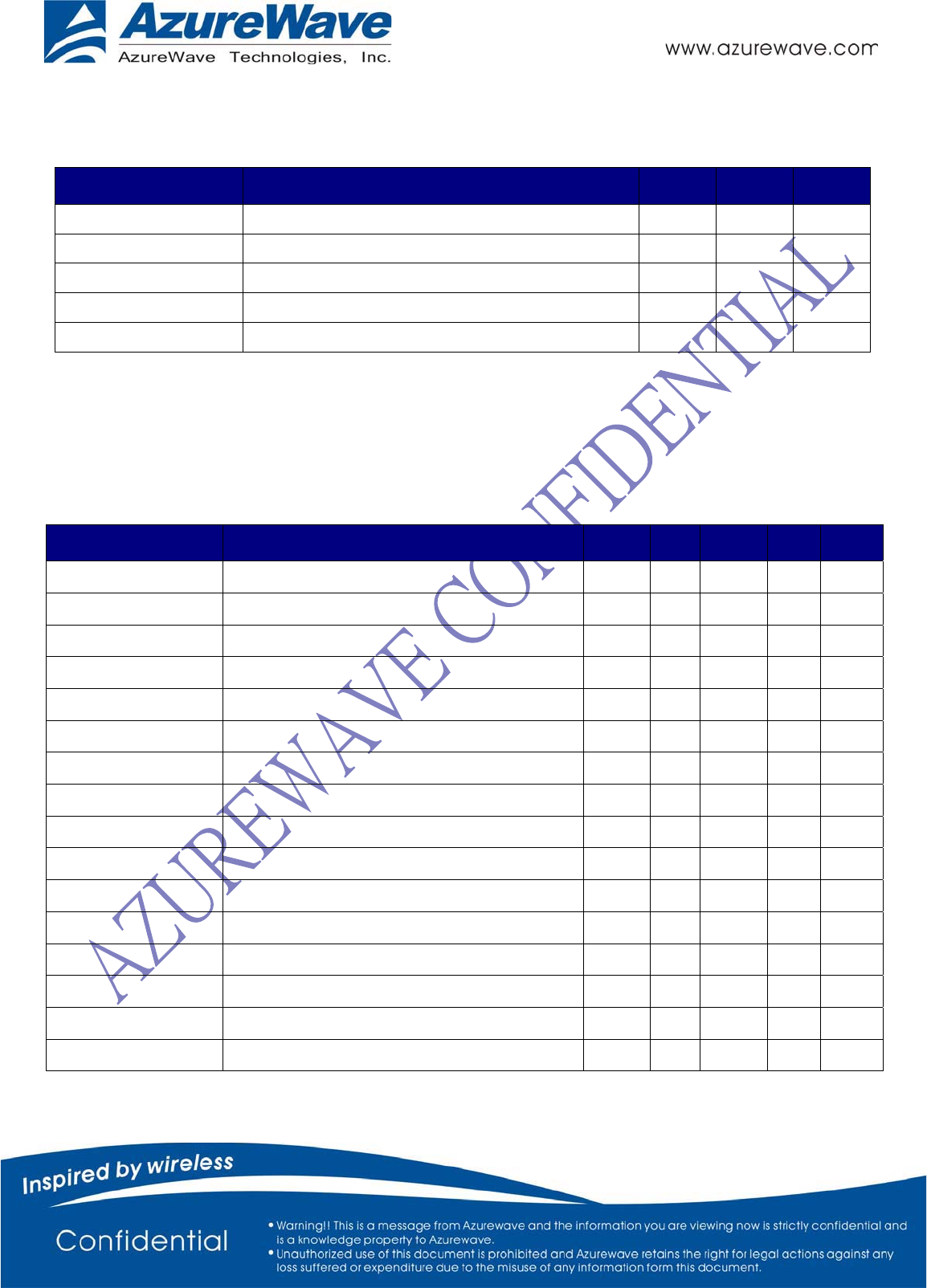
2. Electrical Characteristics
2-1. Absolute Maximum Ratings
Symbol Parameter Min Max Units
VDD_CORE Power supply for Core Voltage Voltage -0.5 1.32 V
VDDIO_SD Host I/O power supply for WL -0.5 4.1 V
VDDIO I/O power supply for BT/FM/GPIO -0.5 4.1 V
VBAT_IN Power supply for Internal Regulators -0.5 6.5 V
VDD_RADIO_PLL_IN Power supply for Noise Sensitive Block (AFE,PLL…) -0.5 1.32 V
2-2. Recommended Operating Conditions
Symbol Parameter Type Min Typ Max Units
VDD1P4_LDO_IN Power supply for Internal CLDO/LDO1 Input 1.35 1.4 2 V
VDD_RADIO_PLL_IN Power supply for Noise Sensitive Block (AFE,PLL…) Input 1.1 1.225 1.35 V
VDD1P2_LDO1_OUT Power supply from Internal LDO1 Output 1.1 1.225 1.35 V
VDD1P4_LNLDO2_IN Power supply for Internal LDO2 Input 1.35 1.4 2 V
VDD_BT_PA Power supply for BT PA Input 3.3 V
VDD_WL_PA Power supply for WL PA G Mode Input 3.3 V
VDD_WL_PA_A_MODE Power supply for WL PA A Mode Input 3.3 V
VBAT_IN Power supply for Internal Regulators Input 2.3 5.5 V
VDD_CORE Power supply for Core Voltage Input 1.1 1.225 1.35 V
VDD1P2_CLDO_OUT Internal LDO for VDD_CORE Output 1.1 1.225 1.35 V
VDDIO_SD Host I/O power supply for WL Input 1.62 1.8/3.3 3.63 V
VDDIO I/O power supply for BT/FM/GPIO Input 1.62 1.8/3.3 3.63 V
VDDIO_RF I/O power supply for RF front-end Input 3.3 V
SR_PA_OUT Power Supply from Internal Buck/Boost Regulator Output 3.3 V
VDD1P2_LNLDO2_OUT Power supply from Internal Output 1.1 1.225 1.35 V
VDD_FM Power Supply for FM Input 1.1 1.225 1.35 V
-9-
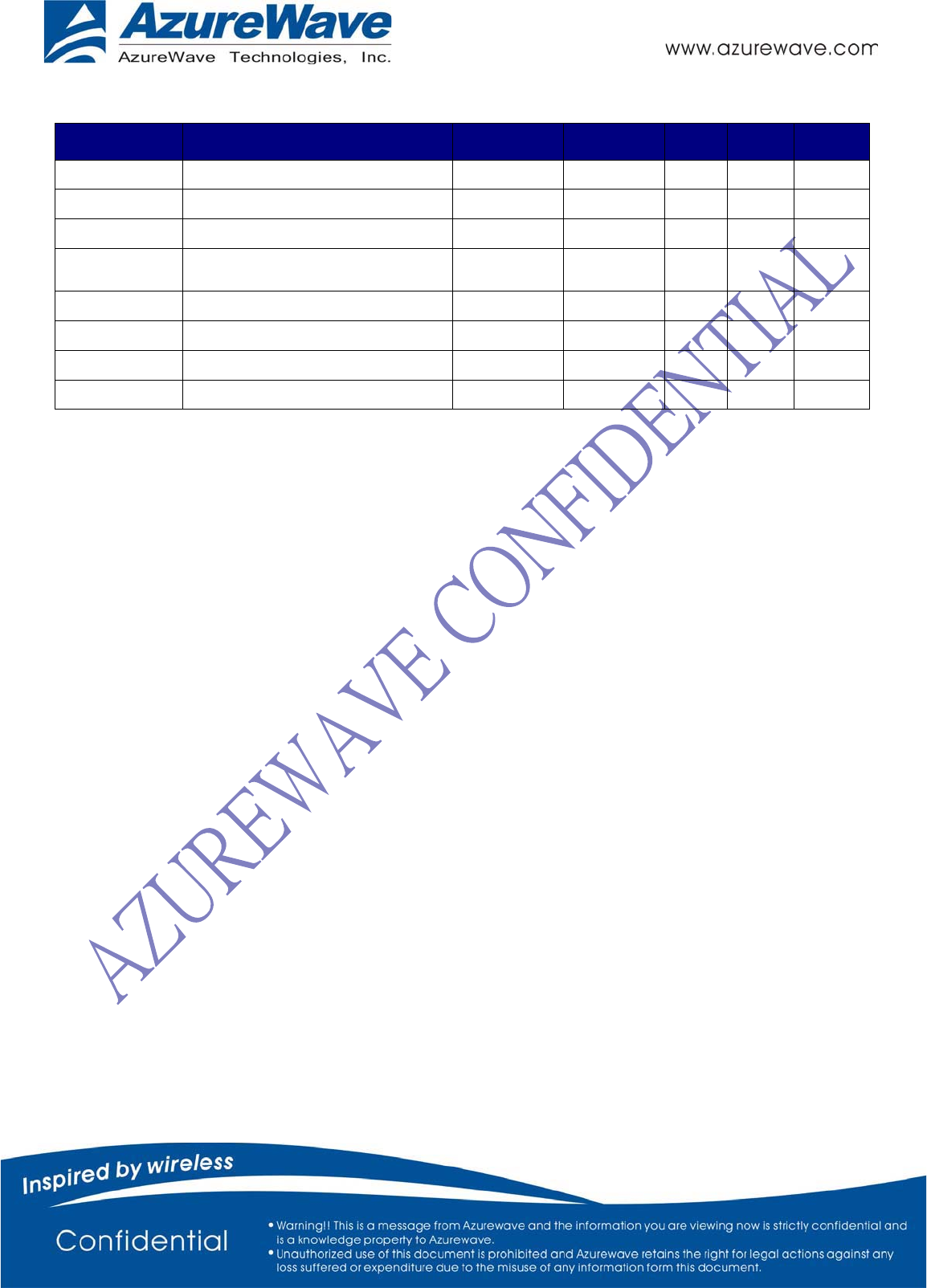
2-3. DC Characteristics for Host I/O
Symbol Parameter Condition Min Typ Max Units
VIL Input low voltage (VDDIO VDDIO
_
SD) 1.8V Logic 0.6 V
VIH Input high voltage (VDDIO VDDIO
_
SD) 1.8V Logic 1.1 V
VOL
(
~100uA Load
)
Output low voltage (VDDIO VDDIO
_
SD) 1.8V Logic 0.2 V
VOH(~100uA Load) Output high voltage (VDDIO
V
)
1.8V Logic VIO - 0.2V V
VIL Input low voltage (VDDIO VDDIO
_
SD) 3.3V Logic 0.8 V
VIH Input high voltage (VDDIO VDDIO
_
SD) 3.3V Logic 2.0 V
VOL
(
~100uA Load
)
Output low voltage (VDDIO VDDIO
_
SD) 3.3V Logic 0.2 V
VOH
(
~100uA Load
)
Output high voltage (VDDIO 3.3V Logic VIO - 0.2V V
2-4. BT/FM Host Interface
The AW-NH931 is the optimal solution for any voice or data application that requires the Bluetooth SIG
standard Host Controller Interface (HCI) using a high-speed UART. The FM subsystem and the
Bluetooth subsystem share the same high-speed UART
2-4-1. UART Interface
The UART physical interface is a standard, 4-wire interface (RX, TX, RTS, CTS) with adjustable baud
rates from 9600 bps to 4.0 Mbps. The interface defaults to a baud rate of 115.2 Kbps coming out of reset.
The desired high-speed baud rate may be selected via a vendor-specific UART HCI command. The AW-
NH931 has a 480-byte receive FIFO and a 480-byte transmits FIFO to support EDR. The interface
supports the Bluetooth 2.1 UART HCI (H4) specification. The default baud rate for H4 is 115.2 k baud.
In order to support both high and low baud rates efficiently, the UART clock can be selected as either 24
or 48 MHz. Generally, the higher speed clock is needed for baud rates over 3 M baud, however a lower
speed clock may be used to achieve a more accurate baud rate under 3 M baud.
The legacy method of programming the high-speed baud rate of the AW-NH931 UART using DHBR and
DLBR values is also supported for backward compatibility with previous-generation Bluetooth devices.
Normally, the UART baud rate is set by a configuration record downloaded after reset, or by automatic
baud rate detection and the host does not need to adjust the baud rate. Support for changing the baud
rate during normal HCI UART operation is included through a vendor-specific command that allows the
host to adjust the contents of the baud rate registers.
The AW-NH931 UART operates correctly with the host UART, provided the combined baud rate error of
the two devices is within ±5%
-10-
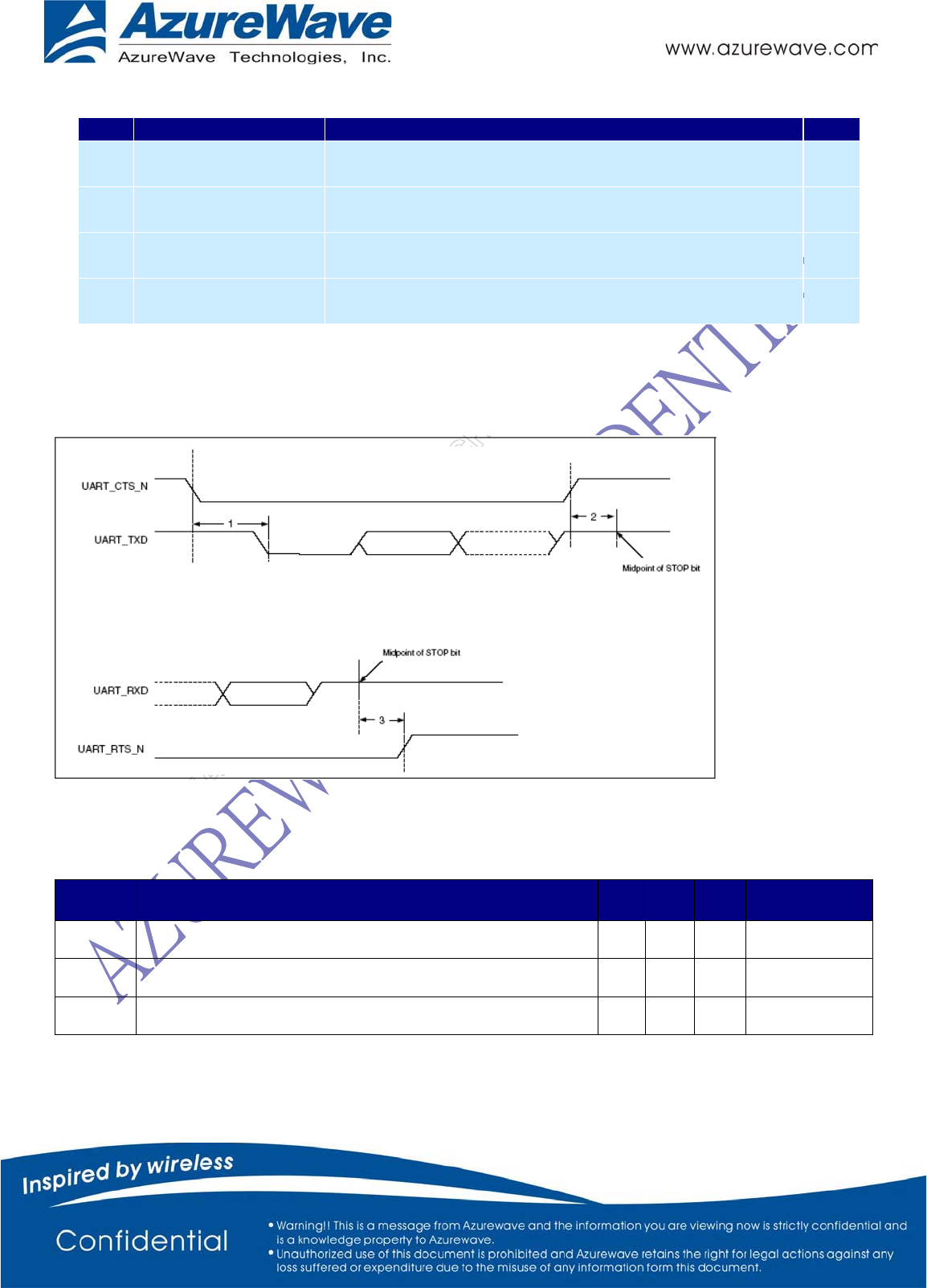
2-4-1.1. UART Interface Signals
Pin No Pin Name Description Type
10 BT_UART_TXD Bluetooth UART Serial Output
Serial data output for the HCI UART Interface O
12 BT_UART_RXD Bluetooth UART Series Input
Serial data input for the HCI UART Interface I
14 BT_UART_RTS_N Bluetooth UART Request to Send.
Active-low request to send signal for the HCI UART interface O
8 BT_UART_CTS_N Bluetooth UART Clear to Send
Active-low clear to send signal for the HCI UART interface. I
2-4-1.2. UART Timing
Values are specified in the recommended operating conditions unless otherwise specified.
Symbol Description Min Typ Max Units
1 Delay time, BT_UART_CTS_N low to UART_TXD valid 24 Baudout cycles
2 Setup time, BT_UART_CTS_N high before midpoint of stop bit 10 ns
3 Delay time, midpoint of stop bit to BT_UART_RTS_N high 2 Baudout cycles
-11-
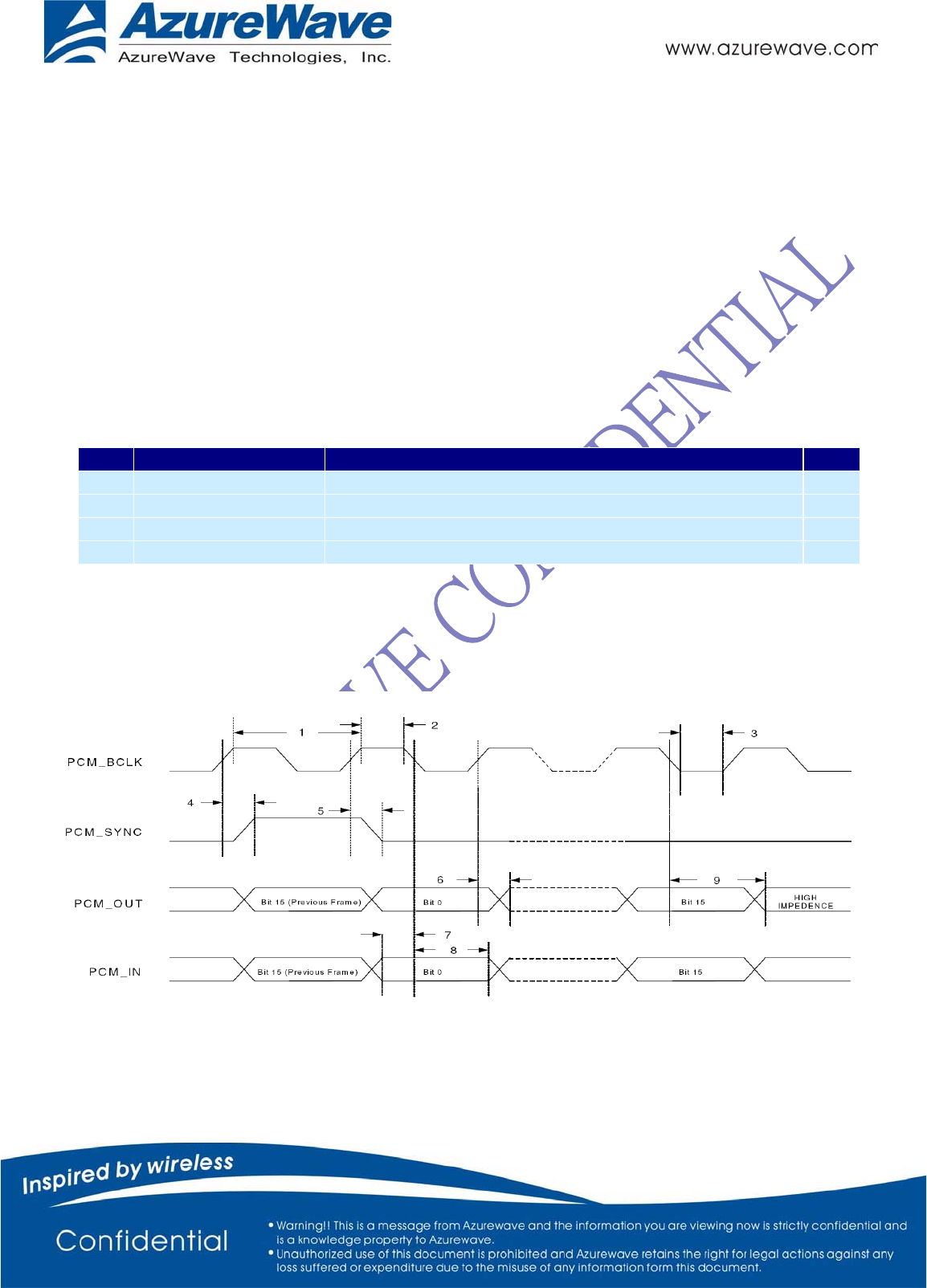
2-4-2. PCM Interface
The PCM Interface on the AW-NH931 can connect to linear PCM Codec devices in master or slave
mode. In master mode, AW-NH931 generates the BT_PCM_CLK and BT_PCM_SYNC signals, and in
slave mode, these signals are provided by another master on the PCM interface and are inputs to the
AW-NH931. The AW-NH931 supports up to three SCO or eSCO channels through the PCM Interface
and each channel can be independently mapped to any of the available slots in a frame. The
configuration of the PCM interface may be adjusted by the host through the use of Vendor Specific HCI
Commands.
2-4-2.1. PCM Interface Signals
Pin No Pin Name Description Type
17 BT_PCM_SYNC PCM sync signal, can be master (output) or slave (input) I/O
5 BT_PCM_OUT PCM data output O
3 BT_PCM_IN PCM data input I
19 BT_PCM_CLK PCM clock, can be master (output) or slave (input) I/O
2-4-2.2. PCM Interface Timing
Short Frame Sync, Master Mode
-12-
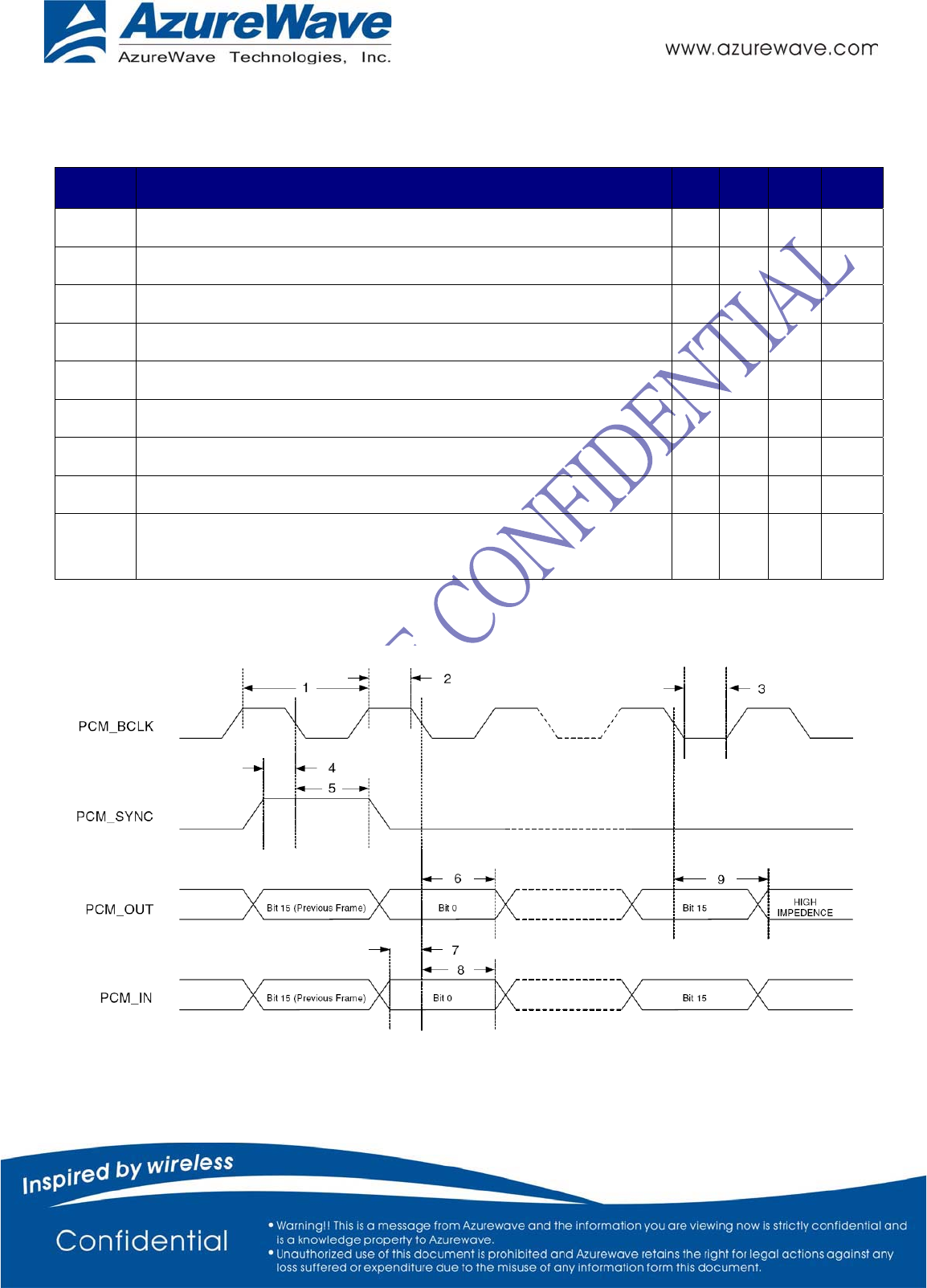
Values are specified in the recommended operating conditions unless otherwise specified.
Symbol Description Min Typ Max Units
1 PCM bit clock frequency 128 2048 kHz
2 PCM bit clock high time 128 ns
3 PCM bit clock low time 209 ns
4 Delay from BT_PCM_CLK rising edge to BT_PCM_SYNC high 50 ns
5 Delay from BT_PCM_CLK rising edge to BT_PCM_SYNC low 50 ns
6 Delay from BT_PCM_CLK rising edge to data valid on BT_PCM_OUT 50 ns
7 Setup time for BT_PCM_IN before BT_PCM_CLK falling edge 50 ns
8 Hold time for BT_PCM_IN after BT_PCM_CLK falling edge 10 ns
9Delay from falling edge of BT_PCM_CLK during last bit period to
BT_PCM_OUT becoming high impedance 50 ns
Short Frame Sync, Slave Mode
-13-
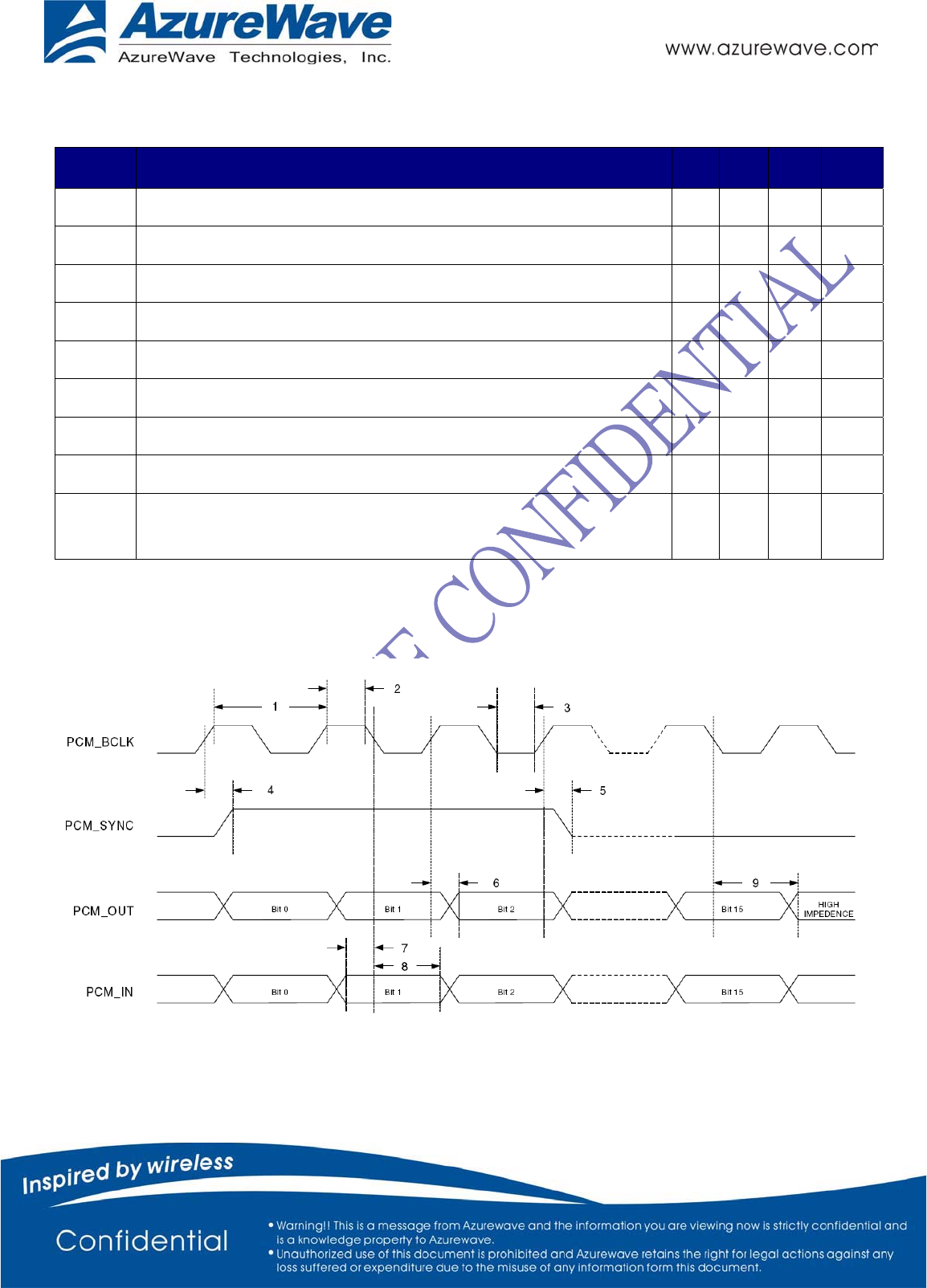
Values are specified in the recommended operating conditions unless otherwise specified.
Symbol Description Min Typ Max Units
1 PCM bit clock frequency 128 2048 kHz
2 PCM bit clock high time 209 ns
3 PCM bit clock low time 209 ns
4 Setup time for BT_PCM_SYNC before falling edge of BT_PCM_BCLK 50 ns
5 Hold time for BT_PCM_SYNC after falling edge of BT_PCM_CLK 10 ns
6 Hold time of BT_PCM_OUT after BT_PCM_CLK falling edge 175 ns
7 Setup time for BT_PCM_IN before BT_PCM_CLK falling edge 50 ns
8 Hold time for BT_PCM_IN after BT_PCM_CLK falling edge 10 ns
9Delay from falling edge of BT_PCM_CLK during last bit period to
BT_PCM_OUT becoming high impedance 100 ns
Long Frame Sync, Master Mode
-14-
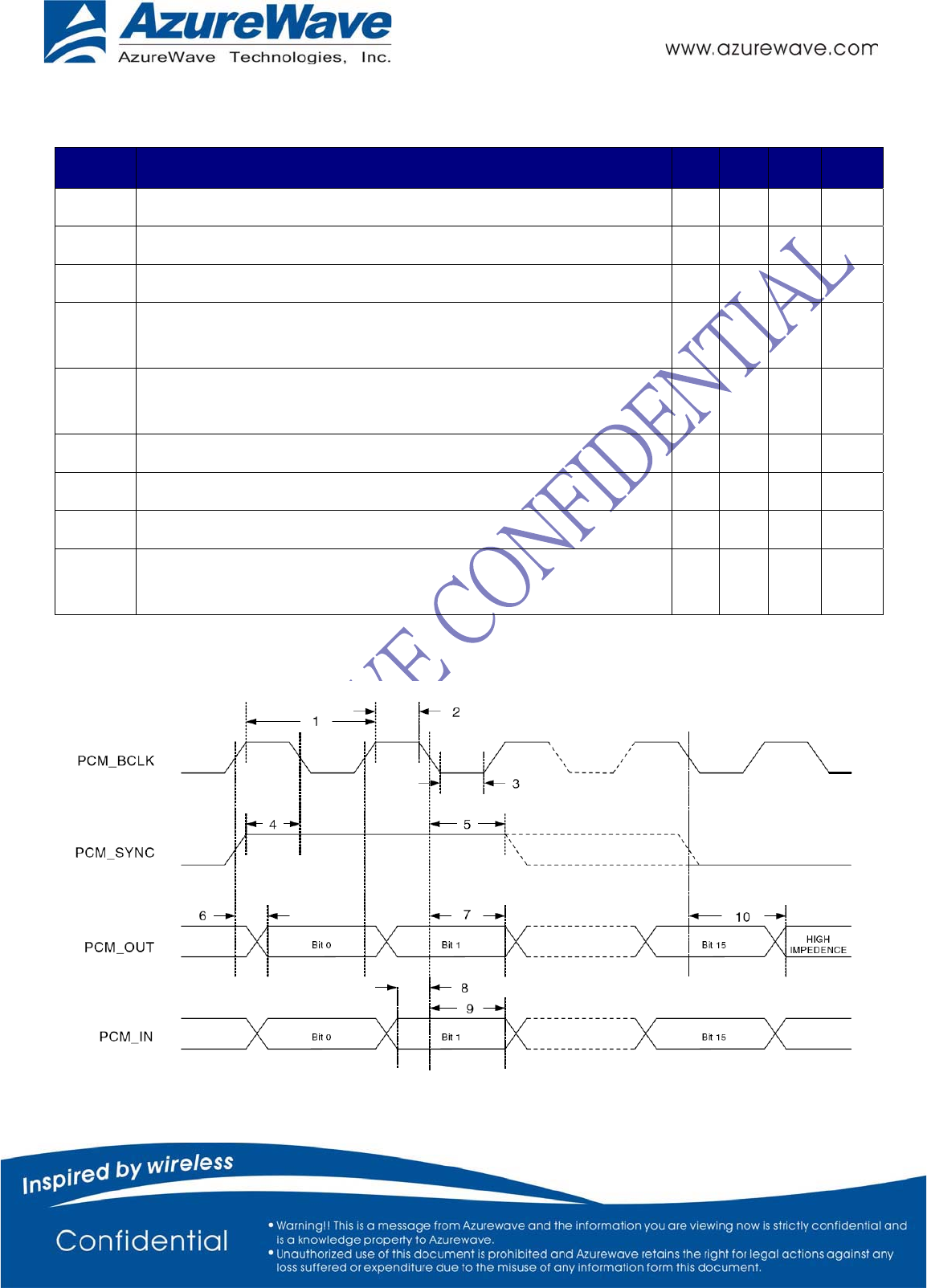
Values are specified in the recommended operating conditions unless otherwise specified.
Symbol Description Min Typ Max Units
1 PCM bit clock frequency 128 2048 kHz
2 PCM bit clock high time 209 ns
3 PCM bit clock low time 209 ns
4Delay from BT_PCM_CLK rising edge to BT_PCM_SYNC high during
first bit time 50 ns
5Delay from BT_PCM_CLK rising edge to BT_PCM_SYNC low during
third bit time 50 ns
6 Delay from BT_PCM_CLK rising edge to data valid on BT_PCM_OUT 50 ns
7 Setup time for BT_PCM_IN before BT_PCM_CLK falling edge 50 ns
8 Hold time for BT_PCM_IN after BT_PCM_CLK falling edge 10 ns
9Delay from falling edge of BT_PCM_CLK during last bit period to
BT_PCM_OUT becoming high impedance 50 ns
Long Frame Sync, Slave Mode
-15-
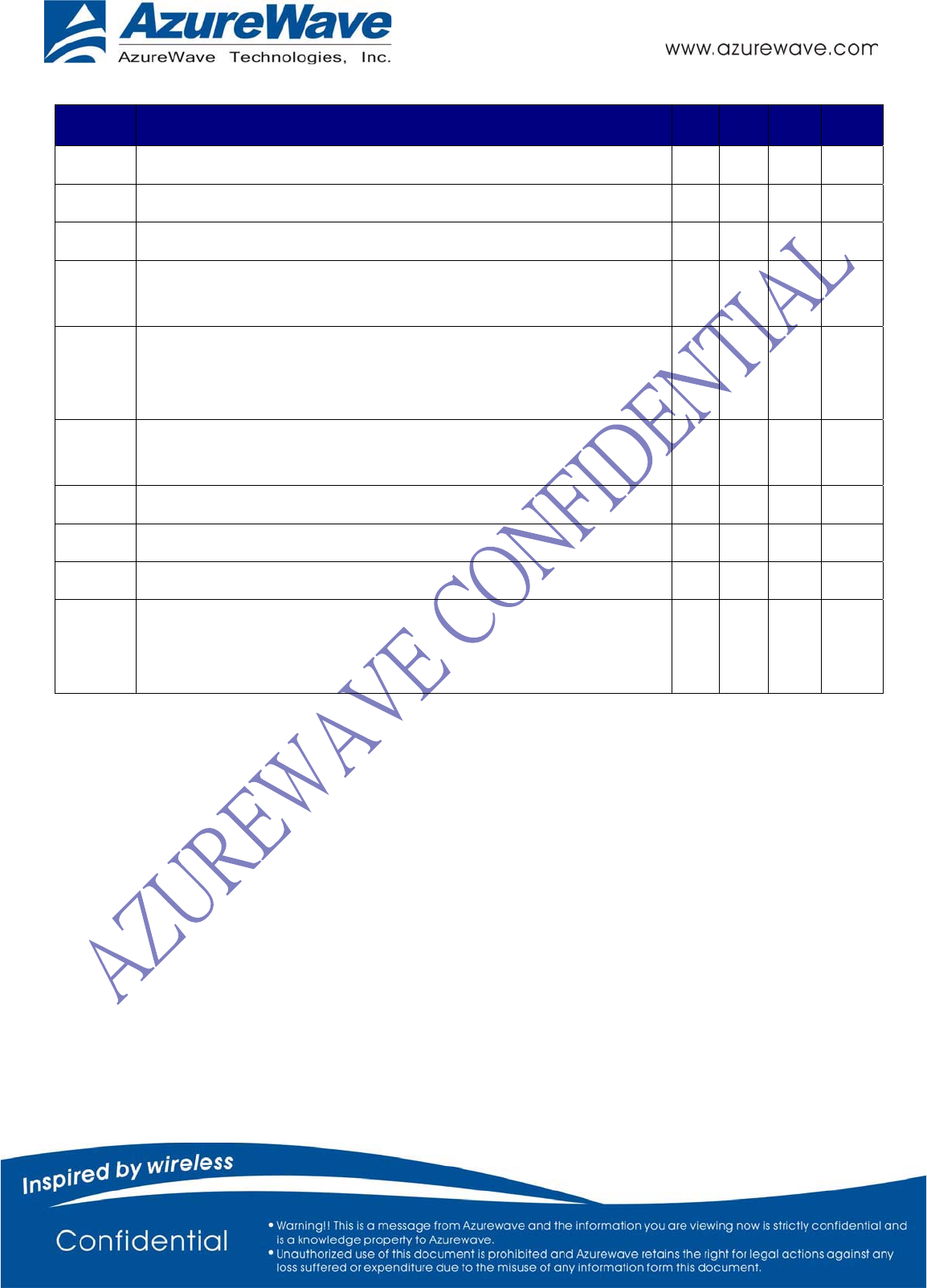
Values are specified in the recommended operating conditions unless otherwise specified.
Symbol Description Min Typ Max Units
1 PCM bit clock frequency 128 2048 kHz
2 PCM bit clock high time 209 ns
3 PCM bit clock low time 209 ns
4Setup time for BT_PCM_SYNC before falling edge of BT_PCM_CLK
during first bit time 50 ns
5
Hold time for BT_PCM_SYNC after falling edge of BT_PCM_CLK during
second bit period. (BT_PCM_SYNC may go low any time from second
bit period to last bit period)
10 ns
6Delay from rising edge of BT_PCM_CLK or BT_PCM_SYNC (whichever
is later) to data valid for first bit on BT_PCM_OUT 50 ns
7 Hold time of BT_PCM_OUT after BT_PCM_CLK falling edge 175 ns
8 Setup time for BT_PCM_IN before BT_PCM_CLK falling edge 50 ns
9 Hold time for BT_PCM_IN after BT_PCM_CLK falling edge 10
10
Delay from falling edge of BT_PCM_CLK or BT_PCM_SYNC (whichever
is later) during last bit in slot to BT_PCM_OUT becoming high
impedance
100 ns
2-5. SDIO Timing
The AW-NH931 has an internal power-on reset (POR) circuit. The device will be held in reset for a
maximum of 110 ms after VDDC and VDDIO have both passed the 0.6V threshold. Wait at least 110 ms
after VDD_CORE and VDDIO are available before initiating SDIO accesses. The external reset signals
are logically ORed with this POR. So if either the internal POR or one of the external resets is asserted,
the device will be in reset.
-16-
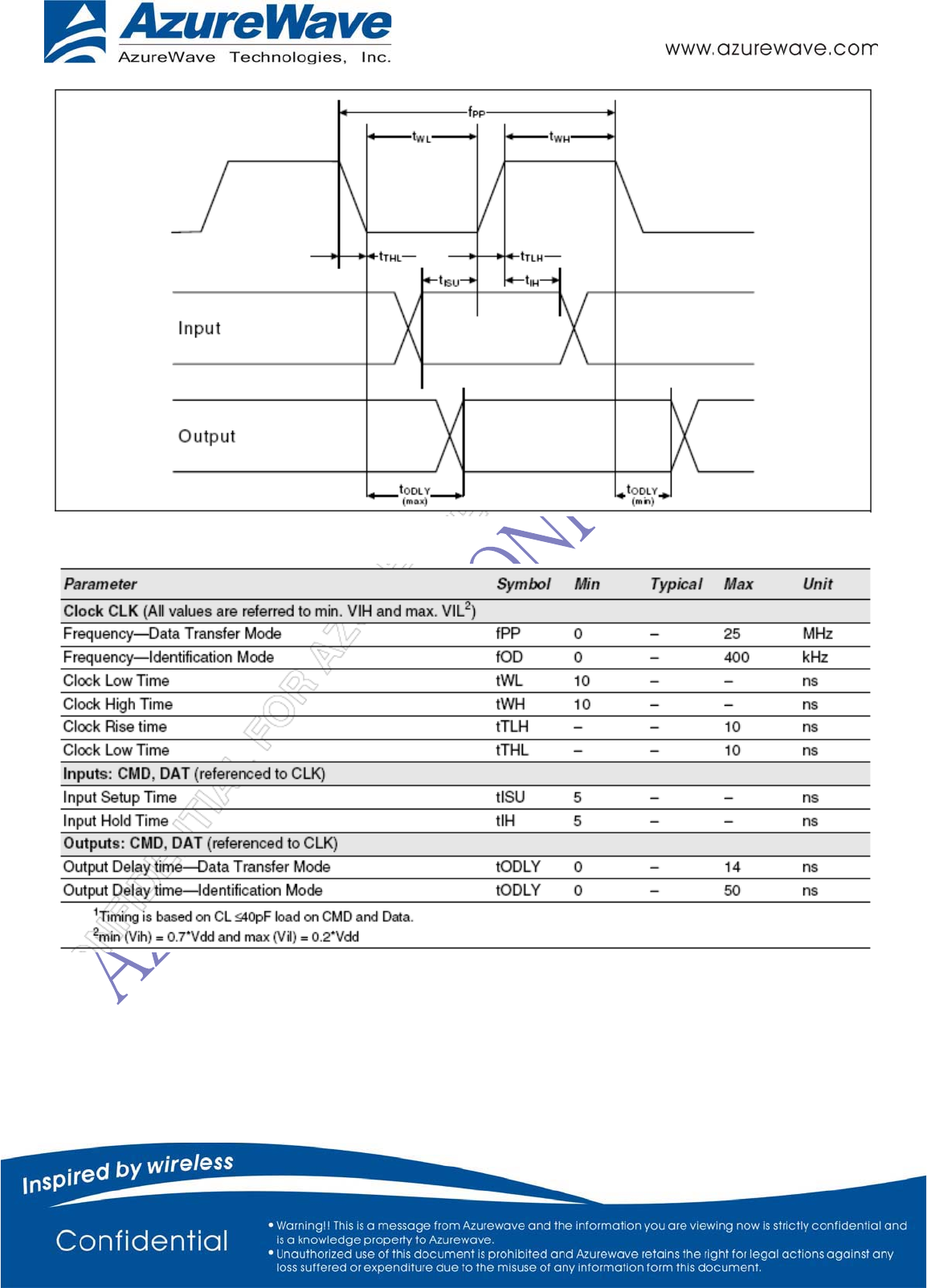
-17-
SDIO Bus Timing(1) (Default Mode)
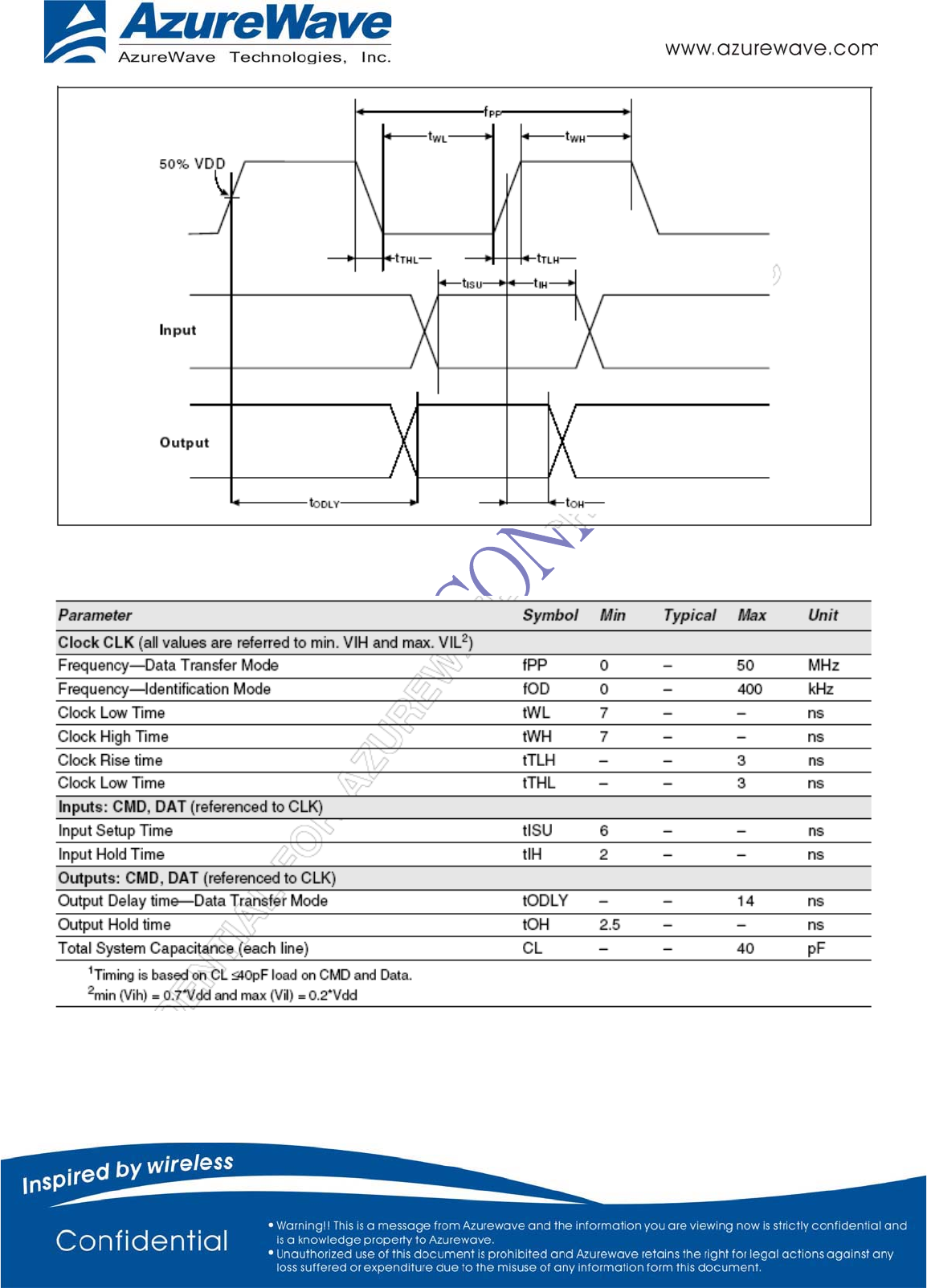
-18-
SDIO Bus Timing (High-Speed Mode)
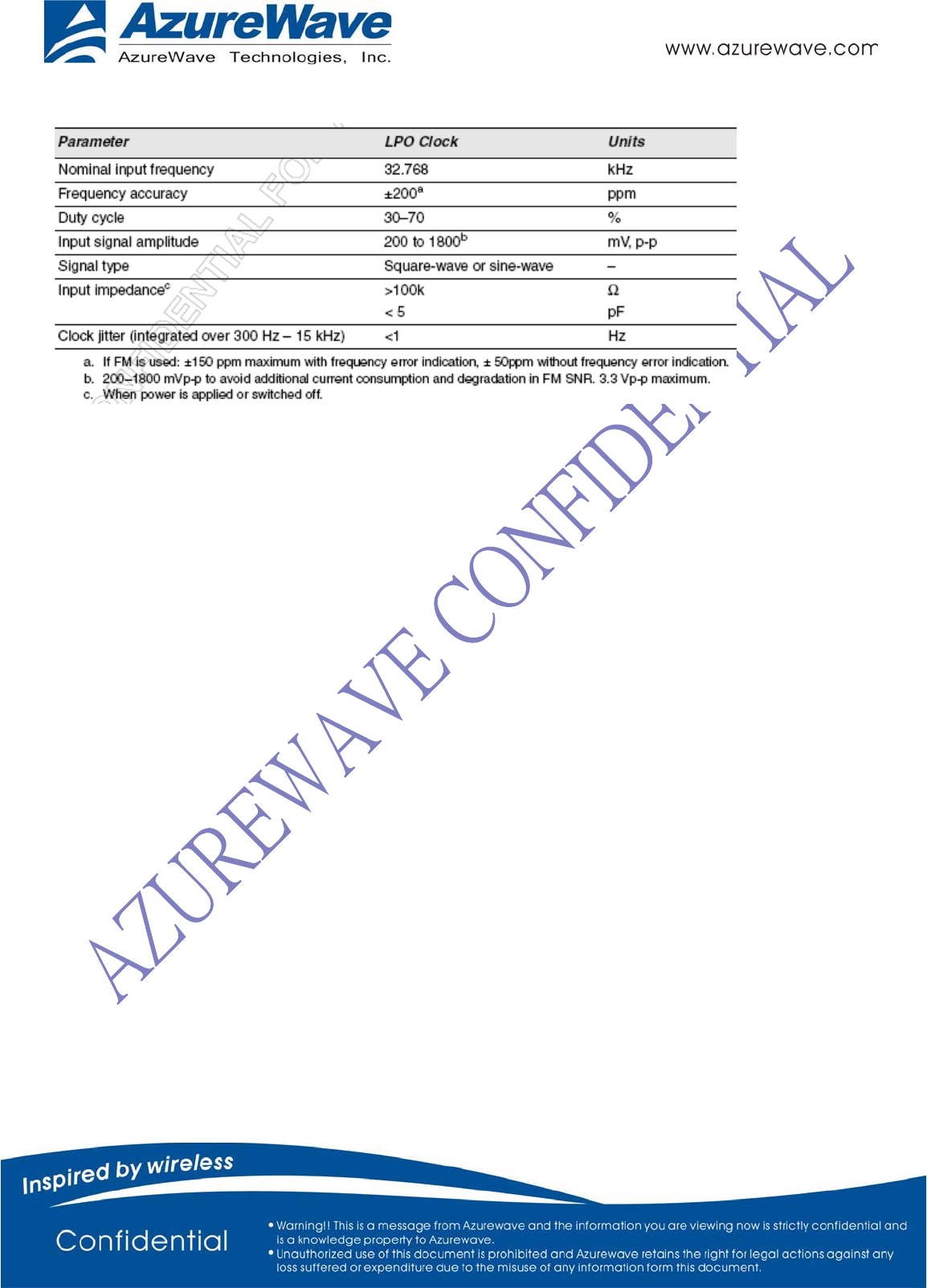
2-6. LPO Clock (RTC_CLK)
2-7. Power-On Sequence
The AW-NH931 has four signals that allow the host to control power consumption by enabling or
disabling the Bluetooth, WLAN and internal regulator blocks. These signals are described below.
Additionally, diagrams are provided to indicate proper sequencing of the signals for carious operating
states. The timing value indicated are minimum required values: longer delays are also acceptable.
Note: The WL_SHUTDOWN_N and BT_SHUTDOWN_N are ORed in the AW-NH931. The diagrams
show both signals going high at the same time (as would be the case if both SHUTDOWN signals were
controlled by a single host GPIO). If two independent host GPIOs are used (on for WL_SHUTDOWN_N
and one for BT_SHUTDOWN_N), then only one of two signals needs to be high to enable the AW-
NH931 regulators.
Also note that the reset requirements for the Bluetooth core are also applicable for the FM core. In other
words, if FM is to be used, then the Bluetooth core must be enabled.
WL_SHUTDOWN_N: Used by the PMU (along with BT_SHUTDOWN_N) to decide whether to power
down the internal AW-NH931 regulators. If both the BT_SHUTDOWN_N and WL_SHUTDOWN_N pins
are low, the regulators will be disabled.
BT_SHUTDOWN_N: Used by the PMU (along with WL_SHUTDOWN_N) to decide whether to power
down the internal AW-NH931 regulators. If both the BT_SHUTDOWN_N and WL_SHUTDOWN_N pins
are low, the regulators will be disabled.
-19-
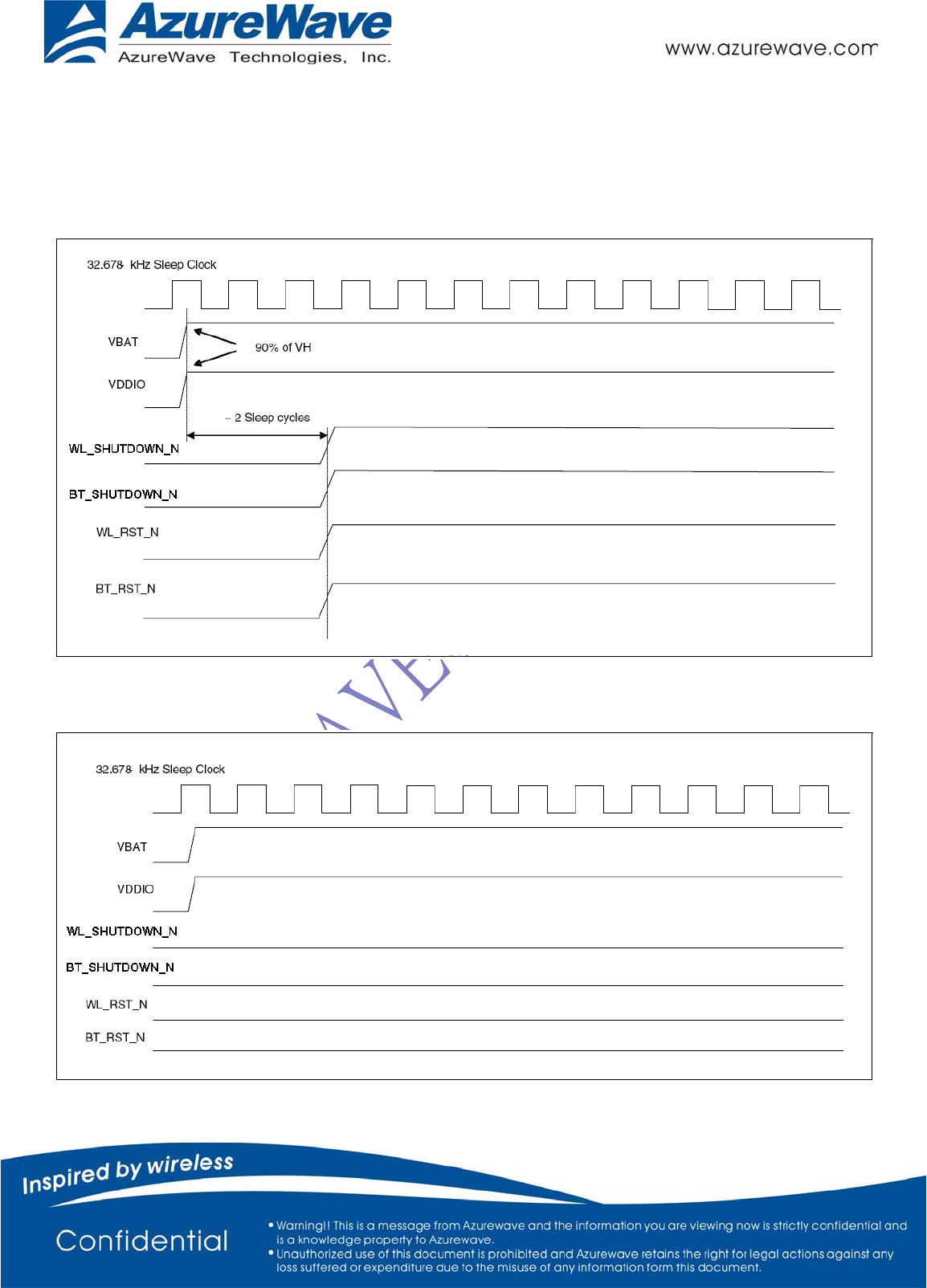
-20-
WL_RST_N: Low asserting Reset for WLAN Core. This pin must be driven high or low ( not left floating ).
BT_RST_N: Low asserting Reset for Bluetooth Core. This pin must be driven high or low (not left
floating).
2-7.1 Power on sequence for WLAN=ON and Bluetooth=ON
2-7.2 Power on sequence for WLAN=OFF and Bluetooth=OFF
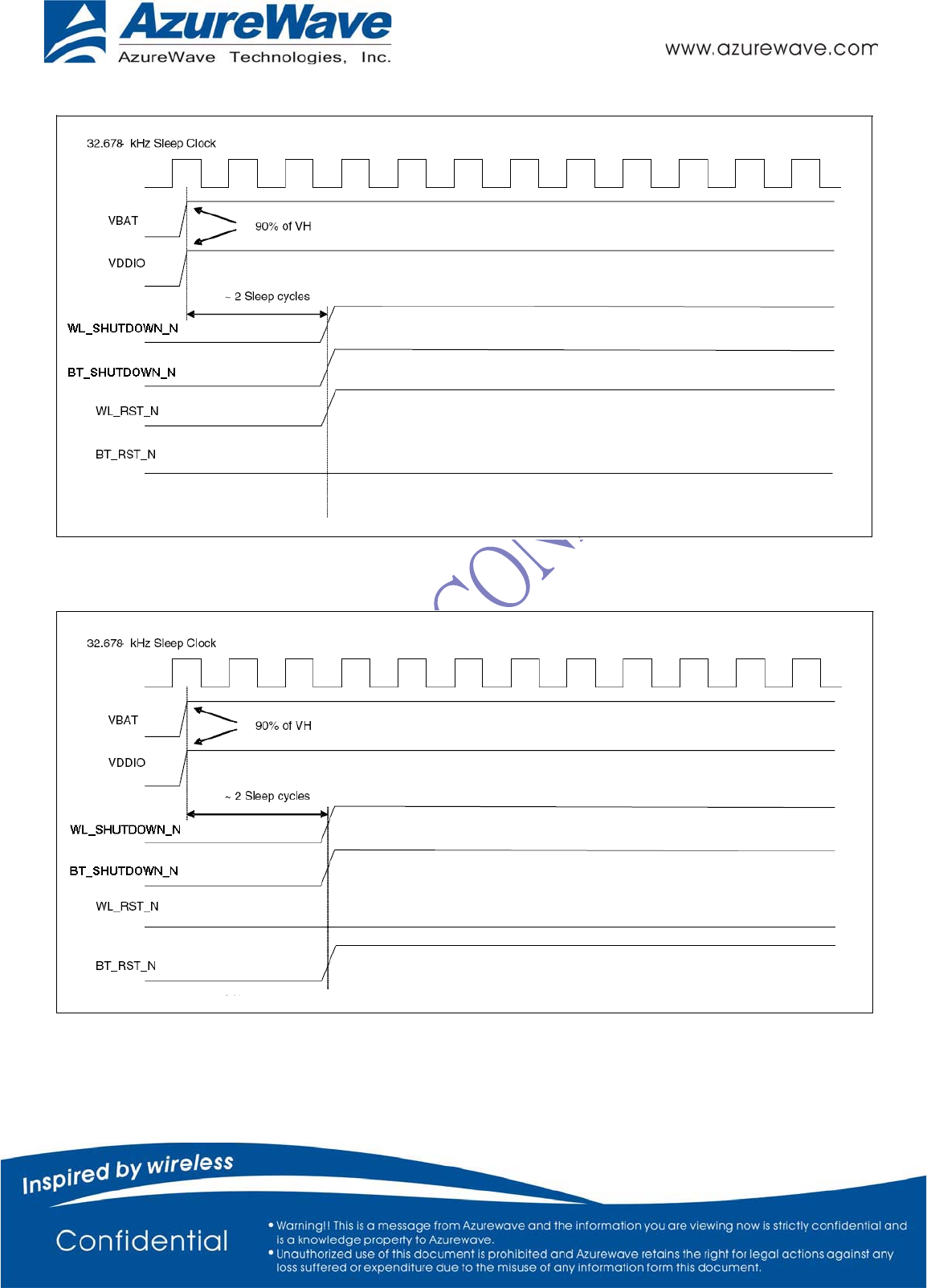
-21-
2-7.3 Power on sequence for WLAN=ON and Bluetooth=OFF
2-7.4 Power on sequence for WLAN=OFF and Bluetooth=ON
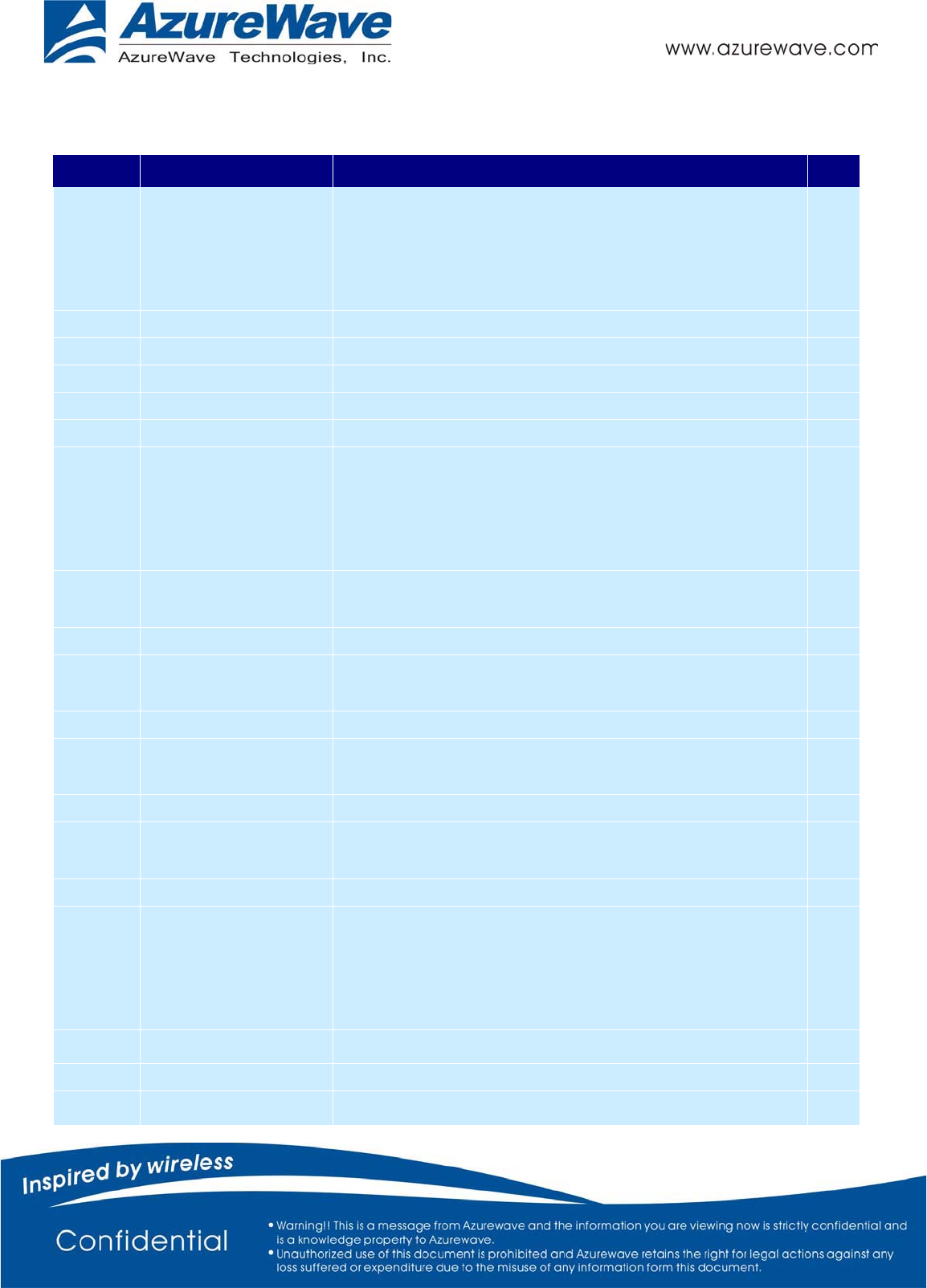
3. Pin Definition
3-1. Pin Description
Pin No Pin Name Description Type
1WL_HOST_WAKE
Host wake up. Signal from the AW-NH931 to the host indicating that the
WLAN device requires attention.
Θ Asserted: Host device must wake-up or remain awake.
Θ Deasserted: Host device may sleep when sleep criteria are met.
The polarity of this signal is software configurable and can be asserted
high or low.
O
2VBAT3V3_IN Power supply for Internal regulators I
3BT_PCM_IN PCM data input (Pin definition for module side) I
4GND Ground
5BT_PCM_OUT PCM data output (Pin definition for module side) O
6NC No Connect
7BT_HOST_WAKE
Host wake up. Signal from the AW-NH931 to the host indicating that the
Bluetooth device requires attention.
Θ Asserted: Host device must wake-up or remain awake.
Θ Deasserted: Host device may sleep when sleep criteria are met.
The polarity of this signal is software configurable and can be asserted
high or low.
O
8 BT_UART_CTS_N
Bluetooth UART Clear to Send
Active-low clear to send signal for the HCI UART interface.
(Pin definition for module side)
I
9GND Ground
10 BT_UART_TXD
Bluetooth UART Serial Output
Serial data output for the HCI UART Interface
(Pin definition for module side)
O
11 FM_AUDIO_L FM Rx analog audio output channel Left (DC Block Capacitor Required) O
12 BT_UART_RXD
Bluetooth UART Series Input
Serial data input for the HCI UART Interface
(Pin definition for module side)
I
13 FM_AUDIO_R FM Rx analog audio output channel Reft (DC Block Capacitor Required) O
14 BT_UART_RTS_N
Bluetooth UART Request to Send.
Active-low request to send signal for the HCI UART interface
(Pin definition for module side)
O
15 GND Ground
16 BT_WAKE
Bluetooth device wake-up: Signal from the host to the AW-NH931
indicating that the host requires attention.
Θ Asserted: Bluetooth device must wake-up or remain awake.
Θ Deasserted: Bluetooth device may sleep when sleep criteria are met.
The polarity of this signal is software configurable and can be asserted
high or low.
I
17 BT_PCM_SYNC PCM sync signal, can be master (output) or slave (input)
(Pin definition for module side)
18 GND Ground
19 BT_PCM_CLK PCM clock, can be master (output) or slave (input)
(Pin definition for module side) I/O
-22-

Pin No Pin Name Description Type
20 BT_RST_N Low Asserting Reset for Bluetooth Core. I
21 GND Ground
22 WL_RST_N Low asserting reset for WLAN. I
23 NC No Connect
24 VBAT3V3_IN Power supply for Internal regulators I
25 NC No Connect
26 GND Ground
27 GND Ground
28 VDDIO Digital I/O power supply for WL/BT/FM (1.8V~3.3V) I
29 GND Ground
30 NC No Connect
31 NC No Connect
32 NC No Connect
33 NC No Connect
34 GND Ground
35 GND Ground
36 NC No Connect
37 SDIO_DATA2_SPI_NC
SDIO 4-bit Mode: Data line 2 or Read Wait
SDIO 1-bit Mode: Read Wait
This pin has an internal weak pull-up resistor. The resistor is enabled by
default but can be disabled by software. The value of the pull-up depends
on the VDDIO_SD supply voltage. For 1.8V, the resistance range is 30–
82 k Ohms. For 2.6V, it ranges from 21–41 k Ohms. For 3.3V, it ranges
from 15–35 kOhms .
I/O
38 NC No Connect
39 SDIO_CLK_SPI_CLK SDIO Clock (Pin definition for module side) I
40 GND Ground
41 SDIO_DATA3_SPI_CS
SDIO 4-bit Mode: Data line 3
SDIO 1-bit Mode: Not used
This pin has an internal weak pull-up resistor. The resistor is enabled by
default but can be disabled by software. The value of the pull-up depends
on the VDDIO_SD supply voltage. For 1.8V, the resistance range is 30–
82 k Ohms. For 2.6V, it ranges from 21–41 k Ohms. For 3.3V, it ranges
from 15–35 kohms
I/O
42 WL_SHUTDOWN_N Low asserting reset for WLAN core. I
43 SDIO_DATA1_SPI_IRQ
SDIO 4-bit Mode: Data line 1 or Interrupt
SDIO 1-bit Mode: Interrupt
This pin has an internal weak pull-up resistor. The resistor is enabled by
default but can be disabled by software. The value of the pull-up depends
on the VDDIO_SD supply voltage. For 1.8V, the resistance range is 30–
82 k Ohms. For 2.6V, it ranges from 21–41 k Ohms. For 3.3V, it ranges
from 15–35 kohms.
I/O
-23-
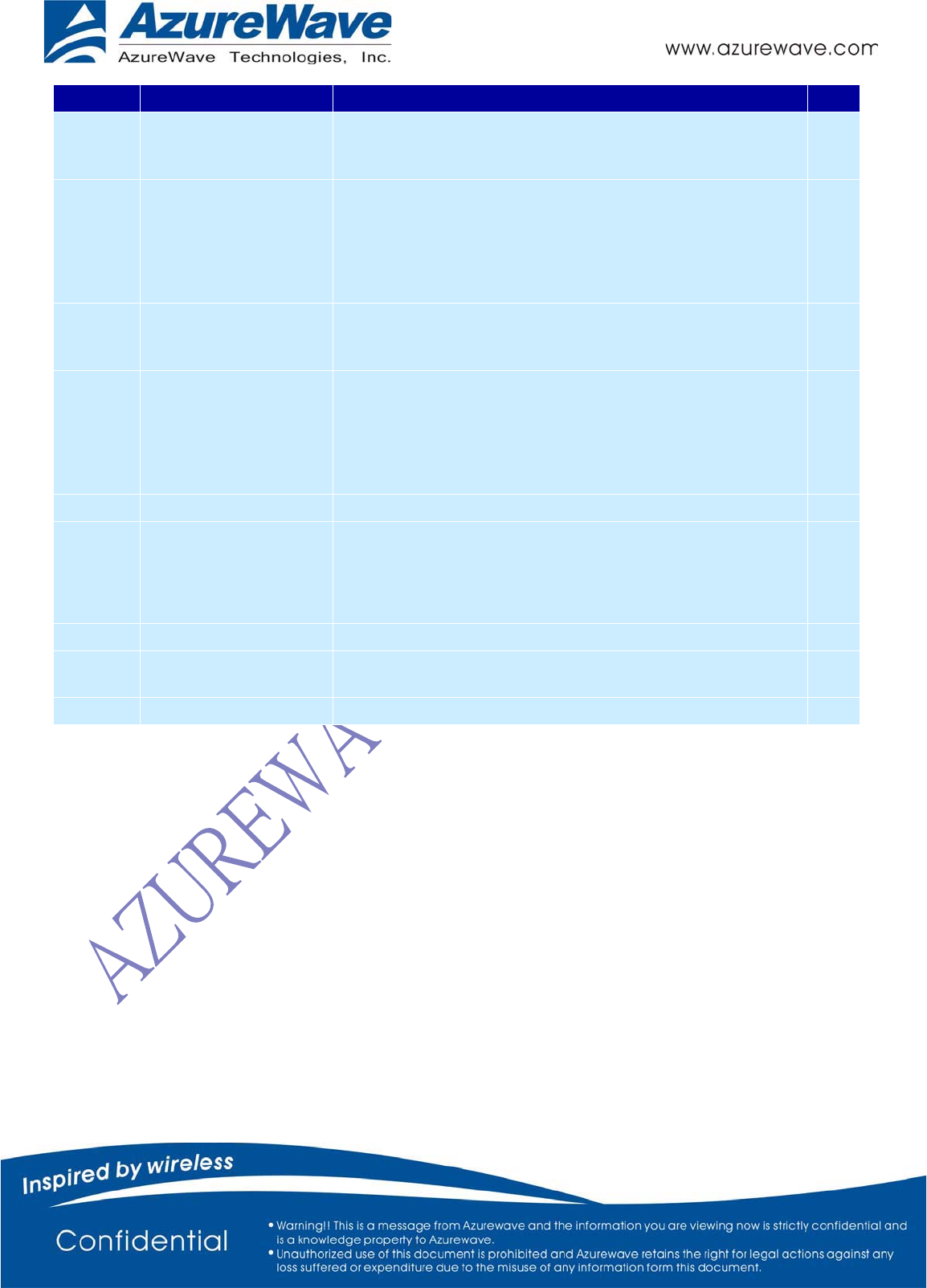
-24-
Pin No Pin Name Description Type
44 WL_GPIO_1
Reserved pin.
WLAN general purpose interface pins. The pin is high-impedance on
power up and reset. Subsequently, they become inputs or outputs
through software control. The pin has programmable pull-up/down.
45 SDIO_CMD_SPI_DI
SDIO 4-bit Mode: Command line
SDIO 1-bit Mode: Command line
This pin has an internal weak pull-up resistor. The resistor is enabled by
default but can be disabled by software. The value of the pull-up depends
on the VDDIO_SD supply voltage. For 1.8V, the resistance range is 30–
82 k Ohms. For 2.6V, it ranges from 21–41 k Ohms. For 3.3V, it ranges
from 15–35 kohms
I/O
46 BT_GPIO_2
Reserved pin.
Bluetooth general purpose interface pin. The pin is high-impedance on
power up and reset. Subsequently, they become inputs or outputs
through software control.
47 SDIO_DATA0_SPI_DO
SDIO 4-bit Mode: Data line 0
SDIO 1-bit Mode: Data line
This pin has an internal weak pull-up resistor. The resistor is enabled by
default but can be disabled by software. The value of the pull-up depends
on the VDDIO_SD supply voltage. For 1.8V, the resistance range is 30–
82 k Ohms. For 2.6V, it ranges from 21–41 k Ohms. For 3.3V, it ranges
from 15–35 kohms
I/O
48 VDDIO_SD SDIO/SPI I/O supply (1.8V ~ 3.3V) I
49 BT_SHUTDOWN_N
Used by PMU (along with WL_SHUTDOWN_N_RST_N) to decide
whether or not to power down internal BCM4329 regulators. If both
BT_SHUTDOWN_N and WL_SHUTDOWN_N_RST_N are low then the
regulators will be disabled.
This signal has an internal 200 kohms pull-down resistor.
The minimum Vih for this pin is 1.36V; the maximum is 3.3V ± 10%.
I
50 GND Ground
51 RTC_CLK
Real Time Clock 32.768KHz input
(Auto-detection of frequencies requires that the RTC_CLK frequency drift < 200
ppm.
I
52 NC No Connect
ϡ All of pin definition for module side
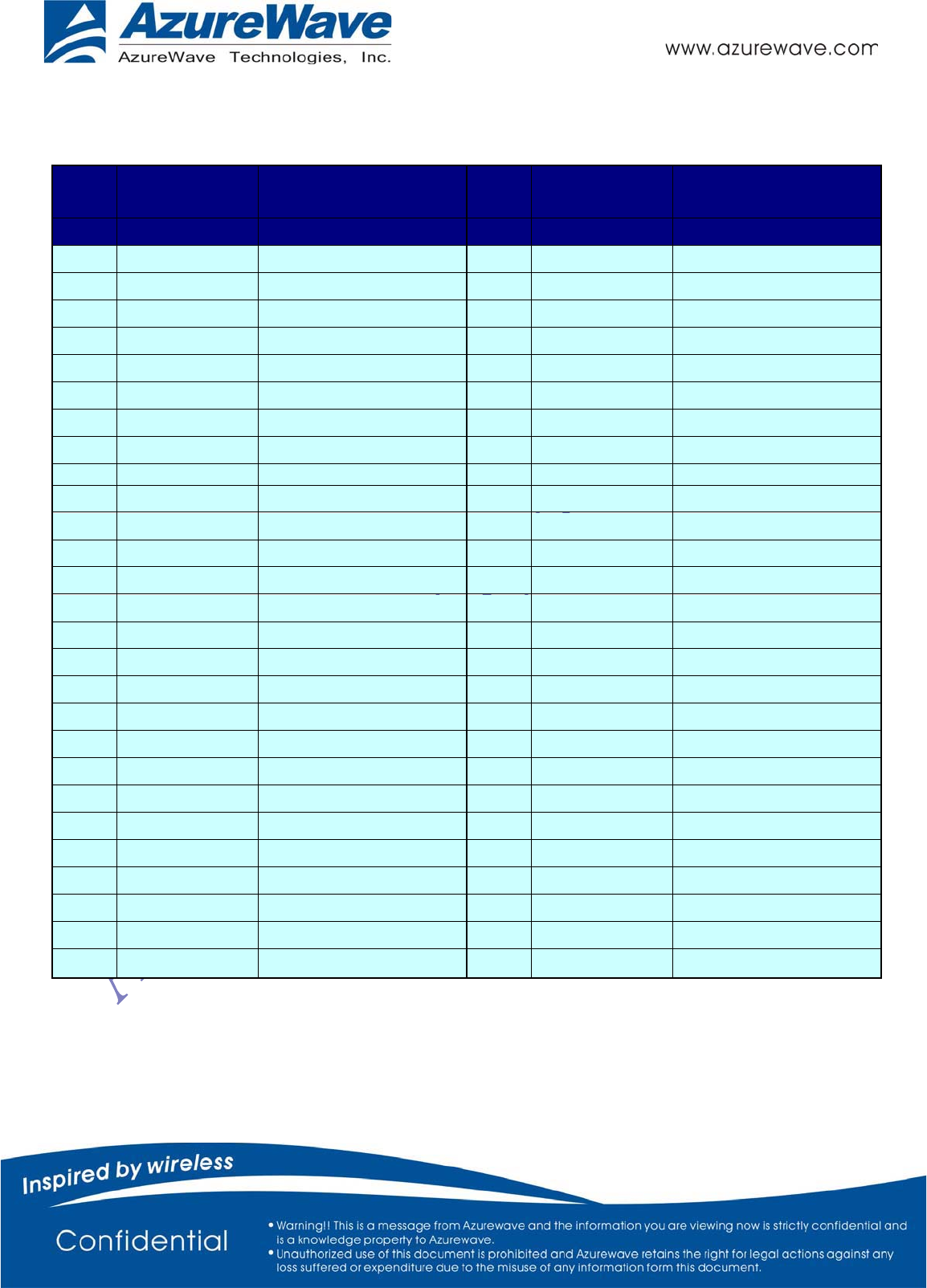
3-2. Pin Description comparison with PCI-Express specification
ʳ
ϡ All of pin definition for module side
ʳ
PCI-Express
Definition AW-NH931 Definition PCI-Express
Definition AW-NH931 Definition
Pin No Name Name Pin No Name Name
1 WAKE# WL_HOST_WAKE 2 3.3Vaux VBAT3V3_IN
3 Reserved BT_PCM_IN 4 GND GND
5 Reserved BT_PCM_OUT 6 1.5V N/A
7 CLKREQ# BT_HOST_WAKE 8 Reserved BT_UART_CTS_N
9 GND GND 10 Reserved BT_UART_TXD
11 RFCLK- FM_AUDIO_L 12 Reserved BT_UART_RXD
13 RFCLK+ FM_AUDIO_R 14 Reserved BT_UART_RTS_N
15 GND GND 16 Reserved BT_WAKE
17 Reserved BT_PCM_SYNC 18 GND GND
19 Reserved BT_PCM_CLK 20 Reserved BT_RST_N
21 GND GND 22 PERST# WL_RST_N
23 PERn0 N/A 24 3.3Vaux VBAT3V3_IN
25 PERp0 N/A 26 GND GND
27 GND GND 28 1.5V VDDIO
29 GND GND 30 SMB_CLK N/A
31 PETn0 N/A 32 SMB_DATA N/A
33 PETp0 N/A 34 GND GND
35 GND GND 36 USB_D- N/A
37 Reserved SDIO_DATA2_SPI_NC 38 USB_D+ N/A
39 Reserved SDIO_CLK_SPI_CLK 40 GND GND
41 Reserved SDIO_DATA3_SPI_CS 42 LED_WWAN# WL_SHUTDOWN_N
43 Reserved SDIO_DATA1_SPI_IRQ 44 LED_WLAN# WL_GPIO_1
45 Reserved SDIO_CMD_SPI_DI 46 LED_WPAN# BT_GPIO_2
47 Reserved SDIO_DATA0_SPI_DO 48 1.5V VDDIO_SD
49 Reserved BT_SHUTDOWN_N 50 GND GND
51 Reserved RTC_CLK 52 3.3Vaux N/A
-25-
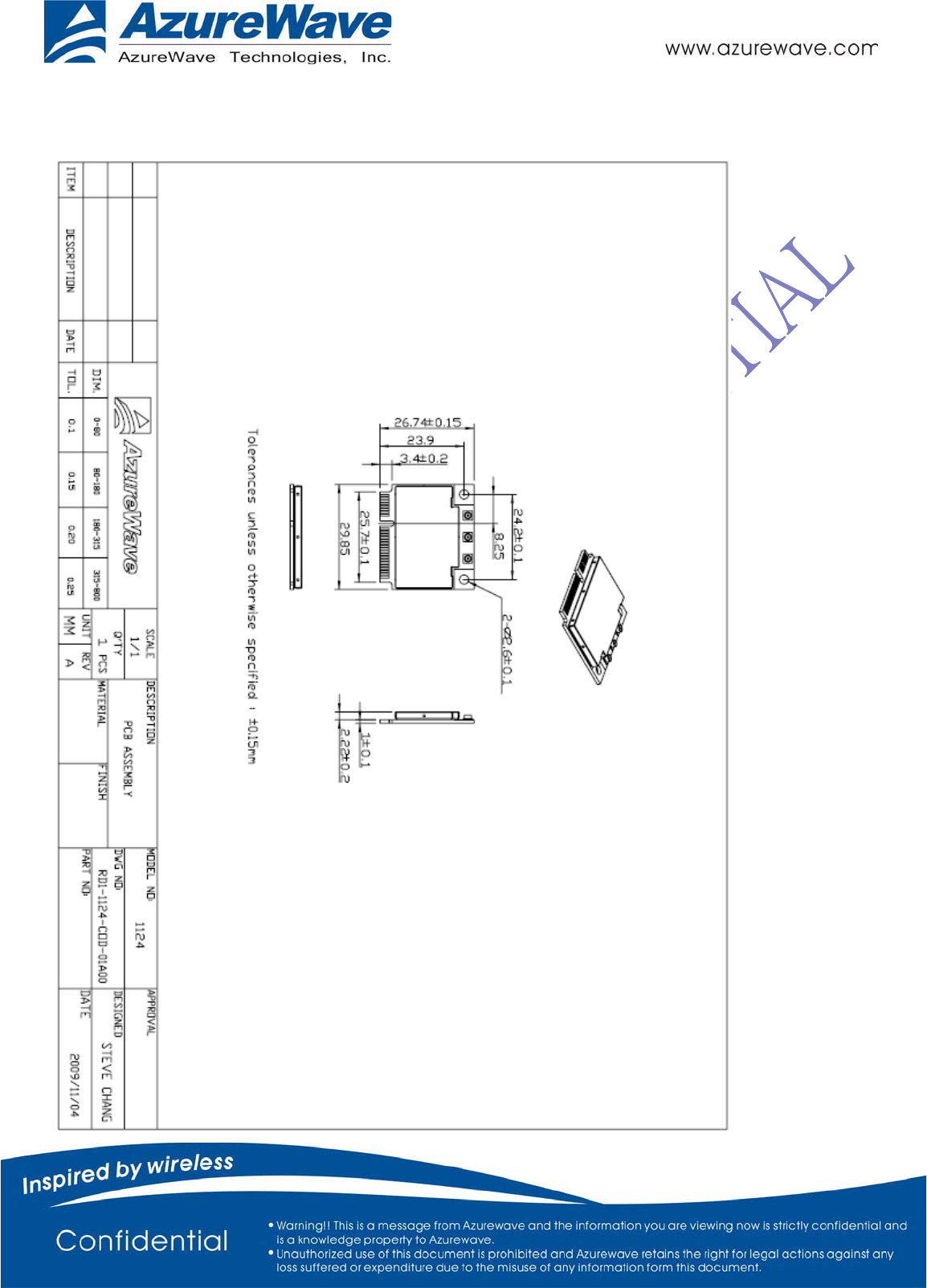
4. Mechanical Information
The size and thickness of the AW-NH931 module is listed below:
-26-
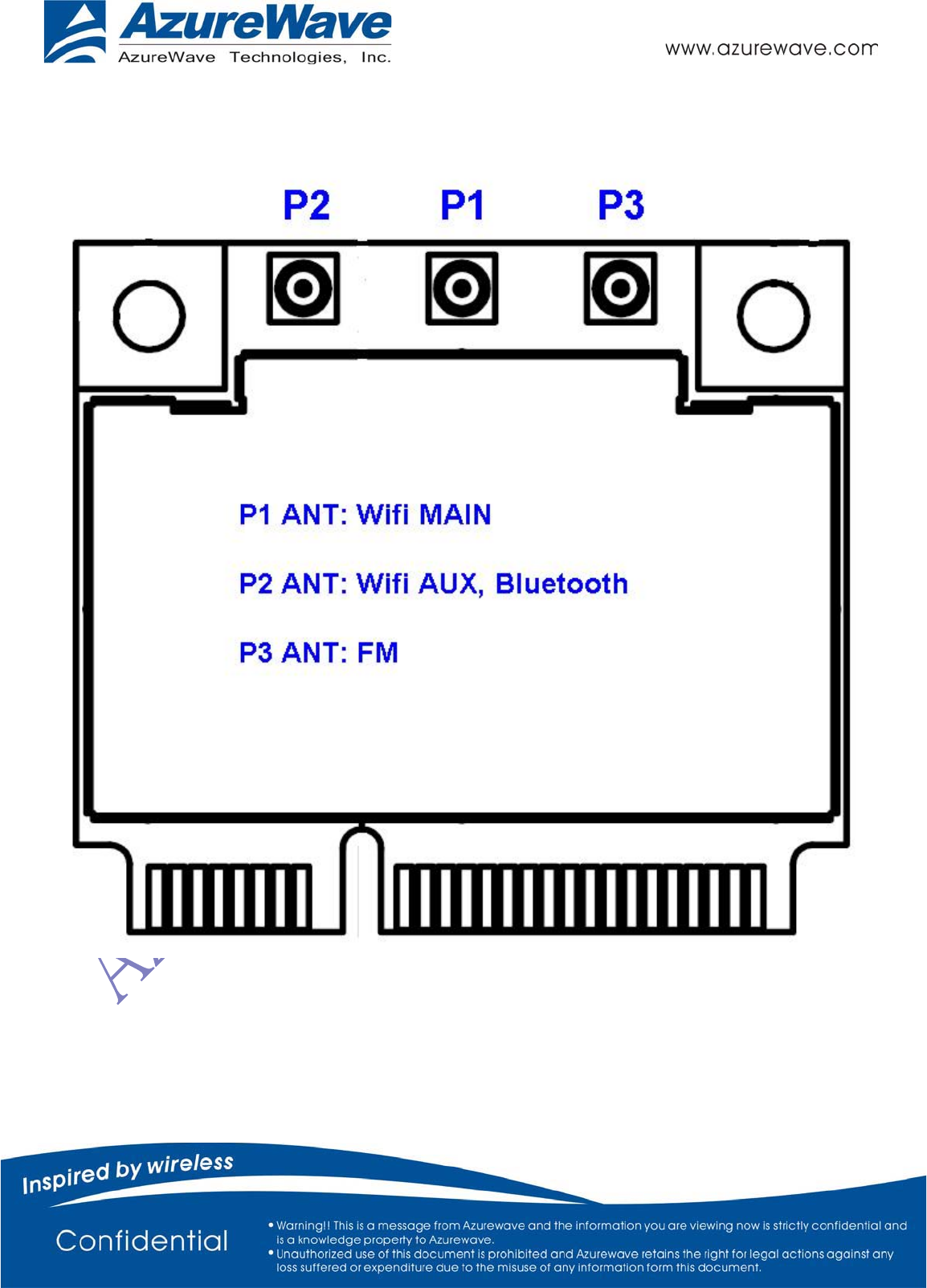
-27-
5. Antenna port Information
FCC Notice :
Federal Communication Commission Interference Statement
This equipment has been tested and found to comply with the limits for a Class B digital device,
pursuant to Part 15 of the FCC Rules. These limits are designed to provide reasonable protection
against harmful interference in a residential installation. This equipment generates, uses and can
radiate radio frequency energy and, if not installed and used in accordance with the instructions,
may cause harmful interference to radio communications. However, there is no guarantee that
interference will not occur in a particular installation. If this equipment does cause harmful
interference to radio or television reception, which can be determined by turning the equipment off
and on, the user is encouraged to try to correct the interference by one of the following measures:
- Reorient or relocate the receiving antenna.
- Increase the separation between the equipment and receiver.
- Connect the equipment into an outlet on a circuit different from that
to which the receiver is connected.
- Consult the dealer or an experienced radio/TV technician for help.
FCC Caution: Any changes or modifications not expressly approved by the party responsible for
compliance could void the user's authority to operate this equipment.
This device complies with Part 15 of the FCC Rules. Operation is subject to the
following two conditions: (1) This device may not cause harmful interference, and (2)
this device must accept any interference received, including interference that may
cause undesired operation.
IMPORTANT NOTE:
FCC Radiation Exposure Statement:
This equipment complies with FCC radiation exposure limits set forth for an uncontrolled
environment. This equipment should be installed and operated with minimum distance 20cm
between the radiator & your body.
This transmitter must not be co-located or operating in conjunction with any other antenna or
transmitter.
This device is intended only for OEM integrators under the following conditions:
1) The antenna must be installed such that 20 cm is maintained between the antenna and
users, and
2) The transmitter module may not be co-located with any other transmitter or antenna,
3) For all products market in US, OEM has to limit the operation channels in CH1 to CH11 for

2.4G band by supplied firmware programming tool. OEM shall not supply any tool or info to
the end-user regarding to Regulatory Domain change.
As long as 3 conditions above are met, further transmitter test will not be required. However, the
OEM integrator is still responsible for testing their end-product for any additional compliance
requirements required with this module installed
IMPORTANT NOTE: In the event that these conditions can not be met (for example certain
laptop configurations or co-location with another transmitter), then the FCC authorization is no
longer considered valid and the FCC ID can not be used on the final product. In these
circumstances, the OEM integrator will be responsible for re-evaluating the end product
(including the transmitter) and obtaining a separate FCC authorization.
End Product Labeling
This transmitter module is authorized only for use in device where the antenna may be installed
such that 20 cm may be maintained between the antenna and users. The final end product must be
labeled in a visible area with the following: “Contains FCC ID: TLZ-NM387”.
Manual Information To the End User
The OEM integrator has to be aware not to provide information to the end user regarding how to
install or remove this RF module in the user’s manual of the end product which integrates this
module.
The end user manual shall include all required regulatory information/warning as show in this
manual.
TLZ-NH931
Industry Canada statement:
This device complies with RSS-210 of the Industry Canada Rules. Operation is subject to the following
two conditions: (1) This device may not cause harmful interference, and (2) this device must accept any
interference received, including interference that may cause undesired operation.
Ce dispositif est conforme à la norme CNR-210 d'Industrie Canada applicable aux appareils radio
exempts de licence. Son fonctionnement est sujet aux deux conditions suivantes: (1) le dispositif ne doit
pas produire de brouillage préjudiciable, et (2) ce dispositif doit accepter tout brouillage reçu, y compris
un brouillage susceptible de provoquer un fonctionnement indésirable.
=========================================================
IMPORTANT NOTE:
Radiation Exposure Statement:
This equipment complies with IC radiation exposure limits set forth for an uncontrolled environment. This
equipment should be installed and operated with minimum distance 20cm between the radiator & your
body.
NOTE IMPORTANTE:
Déclaration d'exposition aux radiations:
Cet équipement est conforme aux limites d'exposition aux rayonnements IC établies pour un
environnement non contrôlé. Cet équipement doit être installé et utilisé avec un minimum de 20 cm de
distance entre la source de rayonnement et votre corps.
This device is intended only for OEM integrators under the following conditions: (For module device use)
1) The antenna must be installed such that 20 cm is maintained between the antenna and users, and
2) The transmitter module may not be co-located with any other transmitter or antenna,
3) For all products market in Canada, OEM has to limit the operation channels in CH1 to CH11 for 2.4G
band by supplied firmware programming tool. OEM shall not supply any tool or info to the end-user
regarding to Regulatory Domain change.
As long as 3 conditions above are met, further transmitter test will not be required. However, the
OEM integrator is still responsible for testing their end-product for any additional compliance
requirements required with this module installed.
Under Industry Canada regulations, this radio transmitter may only operate using an antenna of a type
and maximum (or lesser) gain approved for the transmitter by Industry Canada. To reduce potential radio
interference to other users, the antenna type and its gain should be so chosen that the equivalent
isotropically radiated power (e.i.r.p.) is not more than that necessary for successful communication.
Cet appareil est conçu uniquement pour les intégrateurs OEM dans les conditions suivantes: (Pour
utilisation de dispositif module)
1) L'antenne doit être installée de telle sorte qu'une distance de 20 cm est respectée entre l'antenne et
les utilisateurs, et
2) Le module émetteur peut ne pas être coïmplanté avec un autre émetteur ou antenne,
3) Pour tous les produits vendus au Canada, OEM doit limiter les fréquences de fonctionnement CH1 à
CH11 pour bandes de fréquences 2.4G grâce aux outils de microprogrammation fournis. OEM ne doit
pas fournir d'outil ou d'informations à l'utilisateur final en ce qui concerne le changement de
réglementation de domaine.
Tant que les 3 conditions ci-dessus sont remplies, des essais supplémentaires sur l'émetteur ne seront
pas nécessaires. Toutefois, l'intégrateur OEM est toujours responsable des essais sur son produit final
pour toutes exigences de conformité supplémentaires requis pour ce module installé.
Conformement a la reglementation d'Industrie Canada, le present emetteur radio peut
fonctionner avec une antenne d'un type et d'un gain maximal (ou inferieur) approuve pour l'emetteur par
Industrie Canada. Dans le but de reduire les risques de brouillage radioelectrique a l'intention des autres
utilisateurs, il faut choisir le type d'antenne et son gain de sorte que la puissance isotrope rayonnee
equivalente (p.i.r.e.) ne depasse pas l'intensite necessaire a l'etablissement d'une communication
satisfaisante.

=========================================================
IMPORTANT NOTE:
In the event that these conditions can not be met (for example certain laptop configurations or
co-location with another transmitter), then the Canada authorization is no longer considered valid
and the IC ID can not be used on the final product. In these circumstances, the OEM integrator will
be responsible for re-evaluating the end product (including the transmitter) and obtaining a separate
Canada authorization.
NOTE IMPORTANTE:
Dans le cas où ces conditions ne peuvent être satisfaites (par exemple pour certaines configurations
d'ordinateur portable ou de certaines co-localisation avec un autre émetteur), l'autorisation du
Canada n'est plus considéré comme valide et l'ID IC ne peut pas être utilisé sur le produit final. Dans
ces circonstances, l'intégrateur OEM sera chargé de réévaluer le produit final (y compris l'émetteur)
et l'obtention d'une autorisation distincte au Canada.
=========================================================
End Product Labeling
This transmitter module is authorized only for use in device where the antenna may be installed such
that 20 cm may be maintained between the antenna and users. The final end product must be
labeled in a visible area with the following: “Contains IC: 6100A-NM387”.
Plaque signalétique du produit final
Ce module émetteur est autorisé uniquement pour une utilisation dans un dispositif où l'antenne peut
6100A-NH931
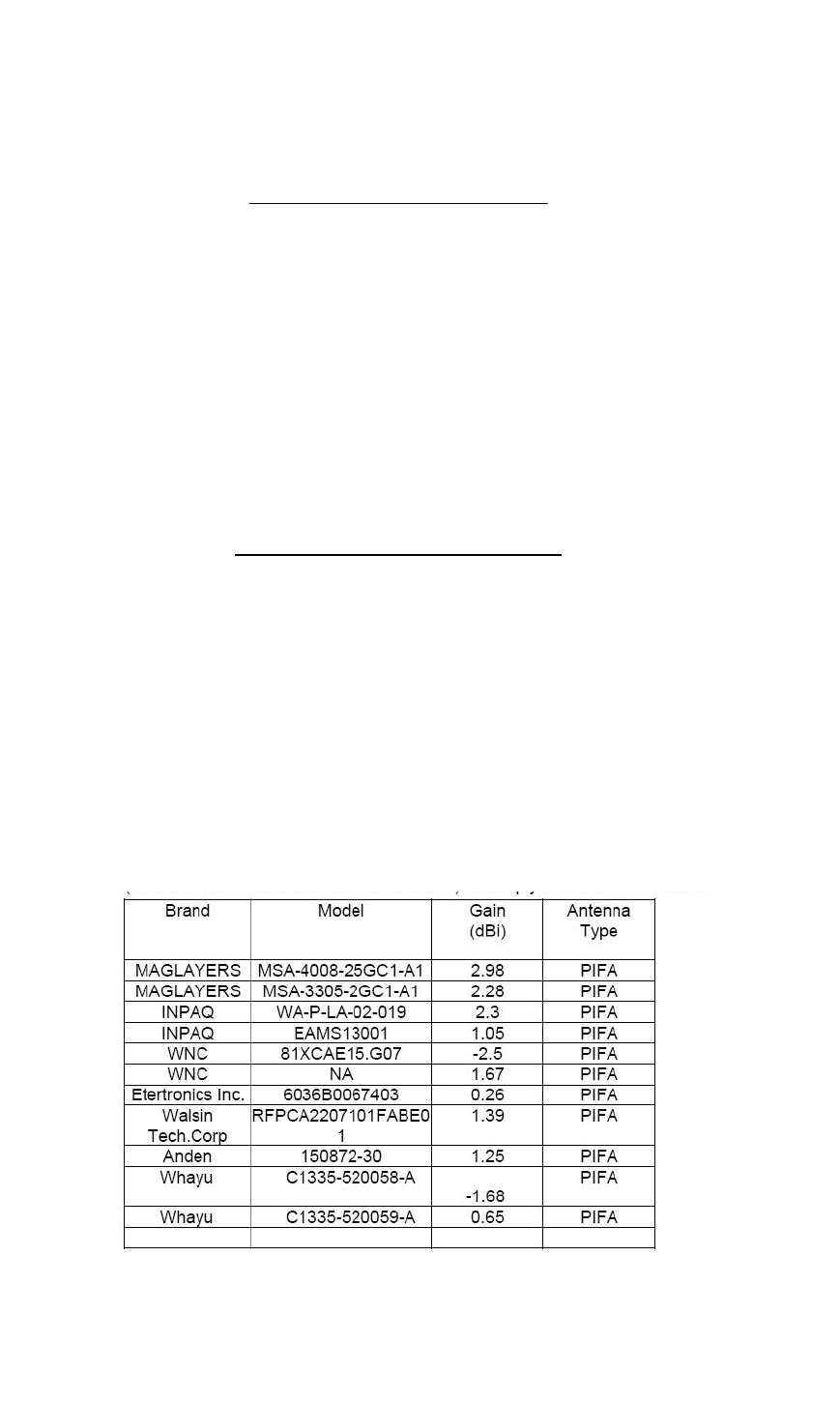
être installée de telle sorte qu'une distance de 20cm peut être maintenue entre l'antenne et les
utilisateurs. Le produit final doit être étiqueté dans un endroit visible avec l'inscription suivante: "Contient
des IC: 6100A-NM387".
=========================================================
Manual Information To the End User
The OEM integrator has to be aware not to provide information to the end user regarding how to
install or remove this RF module in the user’s manual of the end product which integrates this
module.
The end user manual shall include all required regulatory information/warning as show in this
manual.
Manuel d'information à l'utilisateur final
L'intégrateur OEM doit être conscient de ne pas fournir des informations à l'utilisateur final quant à la
façon d'installer ou de supprimer ce module RF dans le manuel de l'utilisateur du produit final qui intègre
ce module.
Le manuel de l'utilisateur final doit inclure toutes les informations réglementaires requises et
avertissements comme indiqué dans ce manuel.
6100A-NH931
This radio transmitter (AW-NH931,IC:6100A-NH931) has been approved by Industry Canada to operate with the antenna
types listed below with the maximum permissible gain and required antenna impedance for each antenna type indicated.
A
ntenna types not included in this list, having a gain greater than the maximum gain indicated for that type, are strictly
prohibited for use with this device.
All antenna's impedance is 50 ohms.